- Skip to right header navigation
- Skip to main content
- Skip to secondary navigation
- Skip to primary sidebar
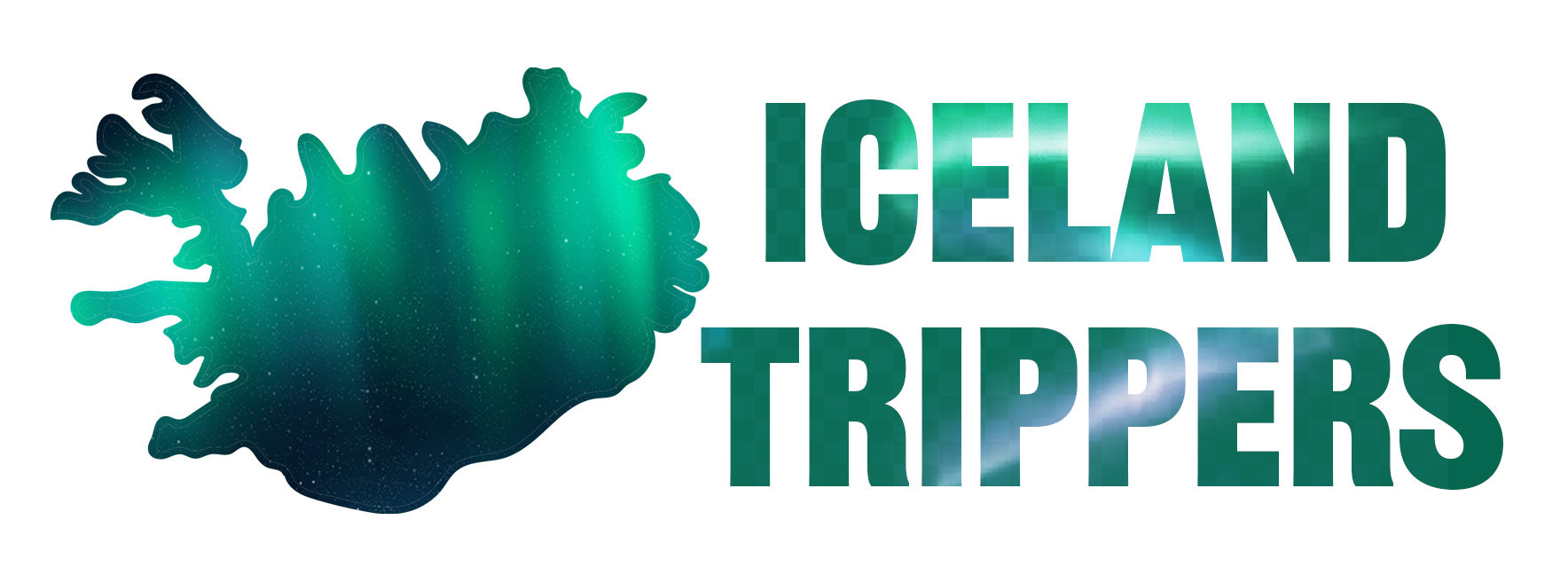
Learn how to easily plan your dream trip to Iceland with helpful guides and tips!
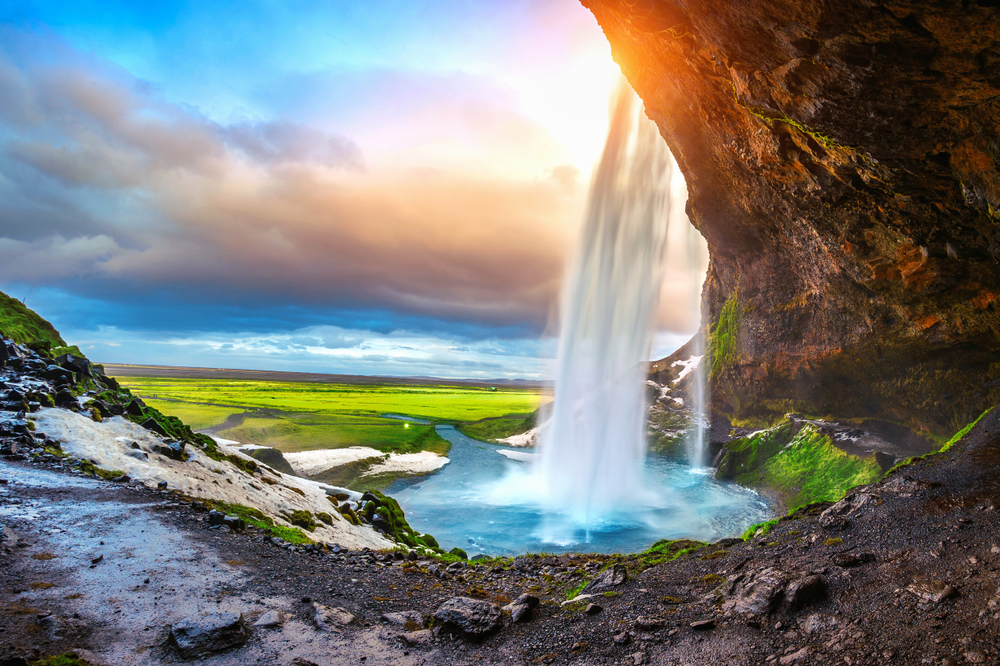

Best (And Worst) Time To Visit Iceland (Month By Month!)
February 19, 2022 // by Iceland Trippers // Leave a Comment
Deciding on the best time to visit Iceland for your needs is one of the most important parts of planning an Iceland trip. If you are unsure where to start, we have made it super easy for you by explaining what you can expect month by month.
This complete guide to the months and seasons of Iceland will fully prepare you for your trip. All of the most common questions are answered, such as when to see special things like the Northern Lights, lupine flowers, and puffins.
Planning your trip to Iceland last minute?
Make sure to book your hotels and tours in Iceland in advance to ensure availability! The longer you wait, the more difficult it gets. Here are my top picks for your trip :
Top Experiences And Tours In Iceland:
- Golden Circle Full Day Tour From Reykjavik (Likely to sell out!)
- Silfra Snorkeling Tour (Includes photos + only small group)
- South Of Iceland Full Day Trip (Our pick!)
- Whale Watching In Reykjavik (On a luxury yacht)
- Northern Lights Bus Tour (Great to go with a local)
- Ice Cave Tour And Glacier Hike (Likely to sell out)
Tickets You MUST book in advance:
- Keflavik > Reykjavik Bus Airport Transfer (Skip the line!)
- Sky Lagoon Entrance Ticket (Includes 7-step spa ritual)
- Blue Lagoon Entry Ticket With Drink (Likely to sell out!)
Top picks for places to stay in Iceland:
- Hotel South Coast (Great central location)
- Grandi Reykjavik (Includes free breakfast)
- Hotel Kria (Close to black sand beach)
- Hotel Skaftafell (Mid-range price)
Iceland is amazing , but it is also a country that must be taken seriously. Winter in Iceland is beautiful, but you must plan accordingly if that is when you are planning to visit. However, even summer has its drawbacks.
Not to worry, we have all the information you need to check off all of your Iceland dreams. The best months to visit Iceland might depend a little bit on the season, but it depends the most on you!
Get a FREE printable “Hidden Gems In Iceland” E-book by joining our private Iceland Facebook Group and sharing your photos and asking for tips and tricks.
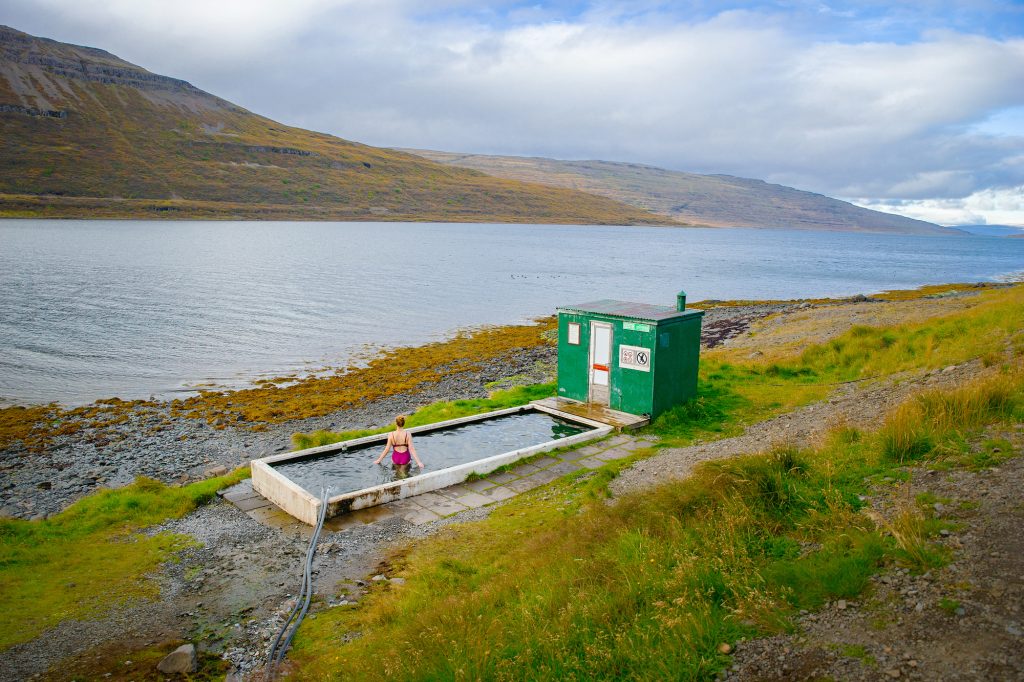
High and Low Seasons for Visiting Iceland
Like any popular tourist destination, Iceland has an “on” season and an “off” season. These times are otherwise referred to as high and low seasons (with the in-betweens being called shoulders).
The high season is when the majority of the tourists come to visit. This is generally due to the nice weather and ease of access. This is when most people plan their Iceland itinerary !
But just because the weather is colder in the low season does not mean you should not visit! Many people enjoy the low and shoulder seasons more because there are fewer crowds and it is cheaper, making it the best time to travel to Iceland for a lot of people.
You might be surprised to learn that there are indoor and outdoor activities for all of the seasons. Iceland is beautiful inside and out no matter when you visit.
High Season: June-August
Summer, summer, summer! This is the high season in Iceland for the obvious reasons: weather and temperature. It is undeniably the best weather to visit Iceland with much more sun and higher temperatures.
However, this is also by far the most expensive time to visit Iceland. Airfare, hotel fees, food prices–everything costs a pretty penny during the summer.
Not to mention the crowds. The high season is high season because it is when most people visit Iceland.
While the cost and the crowds are pretty big negatives, the high season has phenomenal positives as well. Especially if you are wanting to go to Iceland for the great outdoors. Most roads will be open during this time as well.
At the end of the day, it is all about your priorities. If weather and being able to spend the maximum time outside every day is your top priority, you are going to want to come to Iceland during the high season.

Shoulder Season: Sept-Oct & April-May
Shoulder seasons are the traveling industry’s best-kept secret. Okay, so it is not super-secret, but it still is not something people talk about as much as they should.
We hear about the high and low seasons all the time, but not so much about the shoulder seasons. They are the very beginning and the very ending of the classic tourism season.
This means that there are still more people than in the low season, but not the huge crowds of the high season. Prices are a little higher too, but still generally reasonable.
The best part of the shoulder season is that the weather is still reasonable. It may not be as great as the high season, but still totally tolerable!
Low Season: November-March
The low season in Iceland is during the typical winter months. For a country named after ice, Iceland’s winters are not that bad!
While there are some road closures, the country is still quite explorable and traversable during the cold months. And if you are coming to see the Northern Lights, this is the time to do it!
This is also the time to come if you are on a serious budget and need to take advantage of the low season prices. Traveling does not have to empty out your bank account.
The lack of crowds makes it the best season to visit Iceland on a budget! There are some trade-offs for coming during the off-season in Iceland, but there are some definite benefits too. This is actually our favorite time to go!
As we said above, the best time to visit Iceland depends on your Iceland priorities!
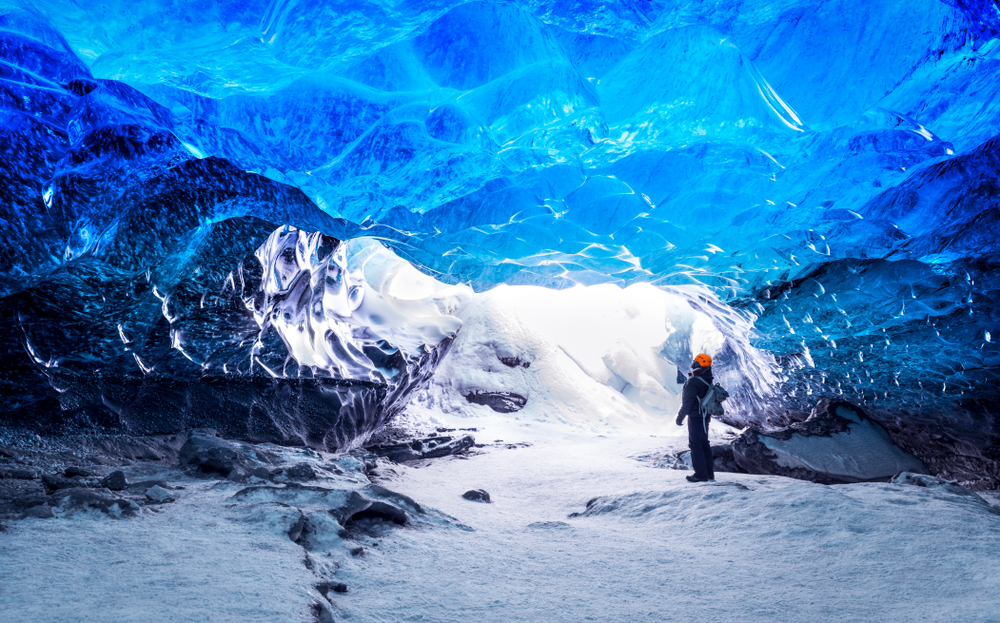
Visit Iceland in Summer if You:
-Love the idea of 24-hour sunshine. Ah, the midnight sun–you are not alone if this is on your bucket list ! If you have dreamt of Iceland’s 24-hour daylight, the summer might be the best time for you to visit.
-Are enamored with the brilliant green of summer. Iceland starts greening back up in the spring, but summer is the best time to visit Iceland if you want to see green everywhere.
The iconic lupine flowers bloom in June and July as well, creating swatches of purple across the landscape. If you want to photograph these flowers make sure to time your trip right.
-Want the best chance to spot whales. Whale watching is a popular tour in Iceland. The magnificent beasts can be spotted offshore from April through October, but the peak time to see them is in the summer.
In summer, more species are in the area and boat tours are less likely to get canceled because of weather.
-Plan on camping. Since the weather is calmer and less unpredictable during the summer, camping in Iceland is a better option for this season. You will have the least rainfall and less wind. This is especially good if you are tent camping.
-Are not bothered by crowds. Everyone loves the gorgeous, summer Iceland scenery. And we mean everyone . Iceland is a super crowded place in summer so keep that in mind.
If you hate crowds, you can still do alright coming in the summer. You will just want to visit the less popular places in the country. They may be less popular, but Iceland is amazing no matter where you go.
-Are totally invested in the traditional sense (read: financially). If you are not concerned about how much your trip to Iceland is going to cost, that saves you a lot of seasonal concerns.
Iceland is stunning in the summer, and we cannot blame you for wanting to visit when everything is so vibrant.
Just keep in mind that it is already expensive to travel to Iceland, let alone during the summer. During the high season, top tourist destinations and locations charge top dollar for everything.

Visit Iceland in Winter if You:
-Want to spot the Northern Lights. You can see the Northern Lights in the fall, but there is a caveat. You will have to stay up until around 2 am. If staying up all night is not your vibe, then winter is the best time to go to Iceland to see the Northern Lights!
In winter, there are not many daylight hours. The sun is only up from around 11 am to 3 pm. However, the increased darkness means a better chance of spotting the Northern Lights. Around midnight is the best time to spot them, but earlier or later is possible too.
-Want to visit an ice cave. The incredibly-formed ice caves are some of the best natural features in Iceland and can only be visited in the winter. Tours are lead from November to March.
-Love a good winter wonderland. There is just something magical about the way snow completely changes Iceland’s landscape. Many people absolutely love coming to Iceland during this time of year because of this.
If you love the beauty of winter, then it is the best time to visit Iceland! Keep in mind that snow has drawbacks since some roads will be closed.
-Want to stand out from the crowd. While a lot of people enjoy Iceland in the winter, the number of people who go is nothing compared to the summer.
If you are looking to do something a little different and unique, winter just might be the best time for your visit to Iceland. It certainly is not a bad time!

Visit Iceland in Fall if You:
-Do not like crowds but still want to see the Northern Lights. Even though this is the off-season, it is prime viewing time for the Northern Lights.
This is because the weather is so nice! You do not have to freeze to see the Northern Lights, just come during the fall.
An extra bonus is that there are really not very many tourists during this time. Fall is the best time of the year to visit Iceland if you want to miss the crowds and do not mind coming when it is a little colder.
-Love fall colors. Iceland is not a country that is typically praised for its fall foliage, mostly because there are not many trees. However, what trees there are turn golden along with the grasses, to create a beautiful landscape.
-Want to experience the Iceland Airwaves music festival. If you have not already heard about it then you might not know what a big deal the Iceland Airwaves music festival is. But if you have heard of it then you already know that it is a must-see!
It is a super popular music festival that happens each fall in Iceland. Usually, it is held sometime in November, but do an internet search to find the exact date.
If you love music, this festival is a great addition to your Iceland plans! Fall is the best time to go to Iceland to check it out!

Visit Iceland in Spring if You:
-Love puffins! Spring is the best time to visit Iceland if you want to see puffins . These adorable birds start arriving around April for their yearly nesting.
Puffins are some of the cutest birds out there, and you can find them all over! If you are coming to catch sight of or photograph them, just check in advance to make sure they will be in the area where you are going.
-Want to road trip without snow. As we said above, some of the roads can close in the winter. Spring is the best time to come to Iceland for better weather and open roads. That melting snow also helps to make the waterfalls flow stronger.
Not to mention that the world is coming back to life in the most beautiful way! There is something about the colorful bursts of color against the gray of winter that makes spring like no other season.
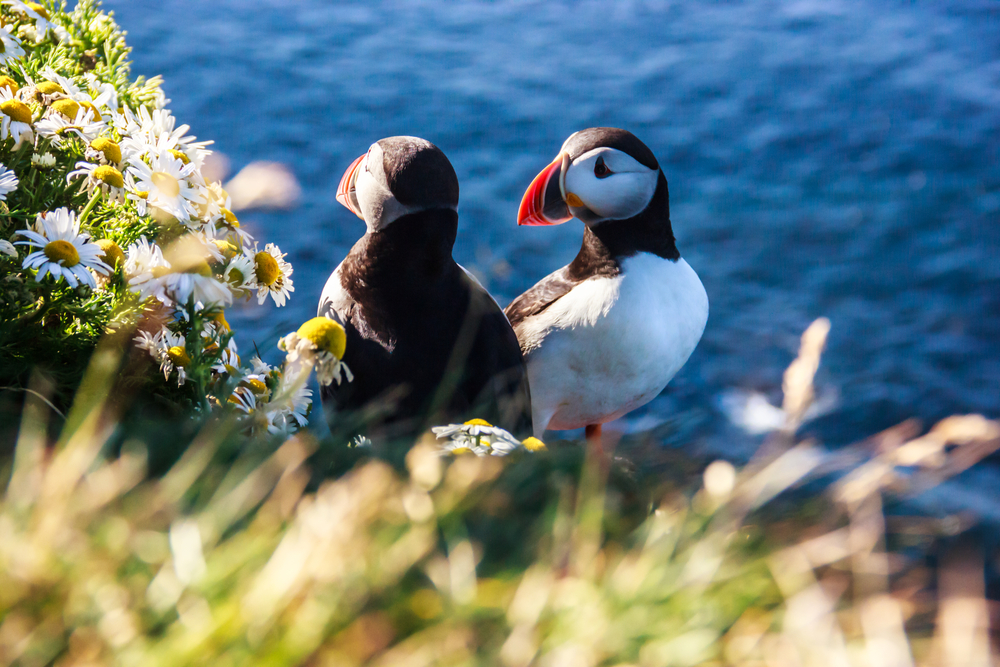
Best Time to See Northern Lights in Iceland
If you are interested in the Northern Lights, you are interested in Iceland! While there are many different places to see the Northern Lights in the world, Iceland is hard to beat.
Especially considering that there are places where you can watch them from a hot tub! The Northern Lights In Iceland are a huge draw, and if they are the reason you are coming you are not alone!
If you are wondering what is the best month to see the Northern Lights in Iceland, there are a few choices. It is possible to see the Northern Lights any month between the end of September and the end of March.
Just like the sun is out all night during summer, the nights are very long in the winter. The closer to mid-winter you visit, the longer the night and thus the higher chance of seeing the lights.
You definitely will not be able to see them during the summer! Winter is when you should book your Iceland trip if the Northern Lights are a priority.
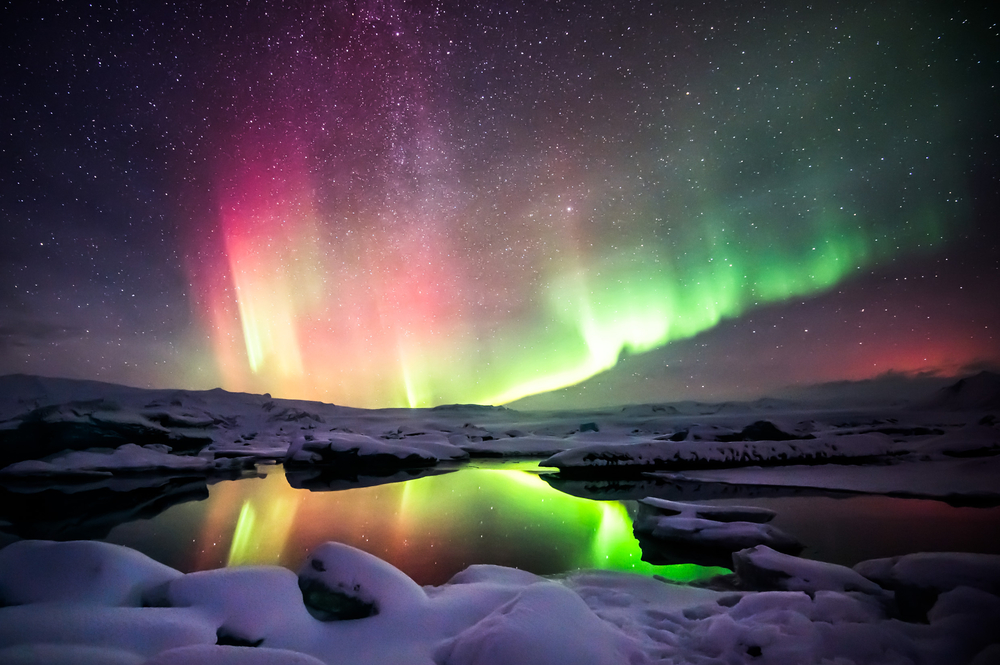
Cheapest Time to Visit Iceland
Unfortunately, Iceland is one of the more expensive countries to visit. We have gone over and over because we believe the experience is worth the money .
However, there are things you can do to make your trip much less expensive. One of those things is visiting during the Iceland off-season.
If it is your goal to do Iceland without dumping a ton of cash, we absolutely recommend the shoulder seasons or winter. Visiting right before or right after the high season of summer can save you a lot of money.
If saving money is a high priority, winter is absolutely the best time to visit Iceland. And pro tip: use grocery stores to cut down on costs even more!
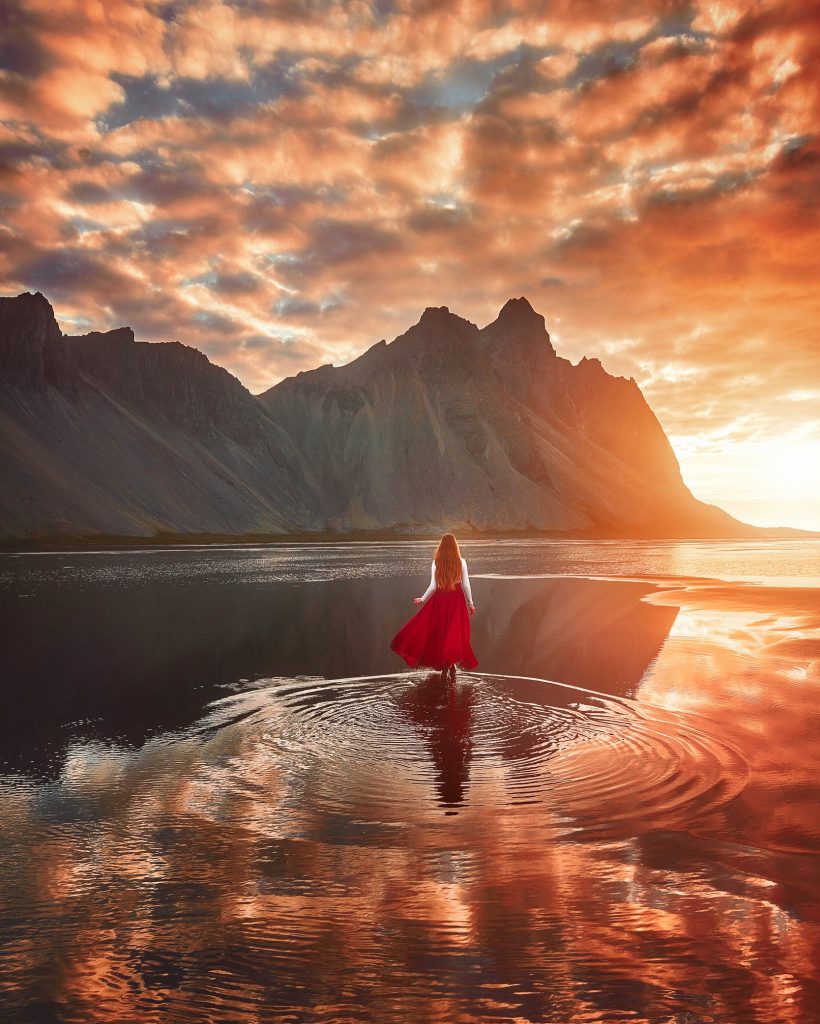
Iceland Weather Breakdown by Month
So far we have been referring to entire seasons, but we know that is kind of broad. Especially when you are planning the trip of a lifetime!
That is why we are going to break everything about Iceland Weather down month by month . This way you can know exactly what to expect.
After all, sometimes the best time to visit Iceland is simply when it best fits into your life. Whenever you make the trip, our month-by-month breakdown will help you make the most of it.
Iceland Weather in January
Happy New Year! January is a great time to visit Iceland. During this time of year you will find highs of about 36 ° F and lows of about 27 ° F.
Is that warmer than you expected? For a country named after ice, Iceland’s winters are actually quite moderate when compared with a lot of other places in the world!
That being said, January in Iceland is the coldest and windiest month. You will want to bring warm clothing and dress appropriately! Expect lots of snow and ice.
Iceland Weather in February
Honestly, the temperatures do not change much in February. What does change is the hours of daylight!
At the beginning of January, you will only get about 4 hours of daylight a day. By the end of February, this increases to about 10 hours.
February is a great month to come because there is more daylight but the crowds and costs are still at a minimum. Check out our post on things to know before you visit Iceland in February!

Iceland Weather in March
March continues with the increase in daylight hours, with about 13 hours of sunshine a day by the end of the month.
Winter weather continues in Iceland in March , although it starts sticking more to the mountaintops and less to the streets. As with most places, the weather is also better in southern Iceland than in northern Iceland.
However, it is still cold pretty much everywhere. We are getting closer to spring, but you would not really know it yet. The temperatures are still averaging between 27 ° F and 36 ° F.
Iceland Weather in April
The weather finally begins to make a bit of a change in April. Temperatures range between 32 ° F and 41 ° F during this warmer month.
What is more, there is a lot less snow! Spring starts to show its face about this time, with the country beginning to green back up again. Migratory birds start to return, including puffins.
We are also looking at around 17 hours of daylight in April as we officially move out of the low season and into the shoulder season. Don’t forget to check out this post about visiting Iceland in April!
Iceland Weather in May
May is seriously one of the best times to visit Iceland! Especially if you love the sun! The days have 20 hours or more of sunlight. It is also the driest month, with the least rainfall.
The highs are also much closer to 50 ° F, which means you almost do not even need a jacket depending on where you are from.
Of course, you will still want to bring your jackets . While the weather is much more temperate, there will still be some cold days. However, it is totally livable and the country is also becoming so much more green!
Iceland in May is also still shoulder season, which means you will not have to try so hard to find your own space while enjoying the sunshine.
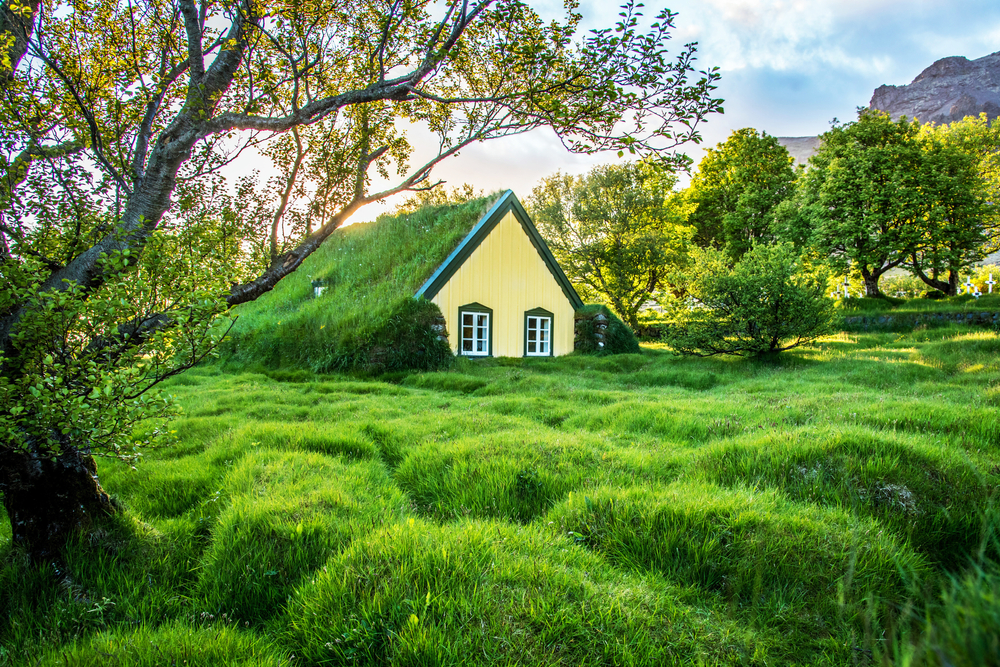
Iceland Weather in June
Welcome to high season! While it is called the high season because it is most popular among tourists, June in Iceland is also the high season for the longest days.
If getting the most out of each day is important to you, then June is the best month to visit Iceland. You can explore for many more hours in daylight.
June nights only last for about 3 hours, beginning around 11:30 PM! Yeah, blackout curtains are a big thing in Iceland summers!
While the highs average around 52 ° F, they can get much higher than that. June is the beginning of summer, and also the beginning of real warmth.
Iceland Weather in July
Now, if you are interested in heat rather than warmth , July might be a better time to visit Iceland. It is the best time of year to visit Iceland for heat, as the hottest month of the year. It is also the least windy month.
The weather in Iceland in July is generally extremely pleasant during this time of the year. While the nights are a little longer, at about 4 hours long, they do not increase by much!
Keep in mind that “hot” does not mean the same thing in Iceland as it does in other places. The average highs are around 56°F. That is part of why it is one of the most popular times to visit because it does not get any warmer than this.
Iceland Weather in August
August is the last month of the high season. While the beginning of the month is still as warm as July, temperatures start to go down by the end of the month.
August is the best time to go to Iceland if you do not mind the crowds due to the fairly standard daylight hours. The sun sets around 9 PM and rises around 5 AM. August has the least cloudy days as well.
Do keep in mind that August in Iceland goes quickly from summer to fall. By the end of the month, the slight bite to the air will have you wishing for warm pumpkin pie and spiced apple cider.
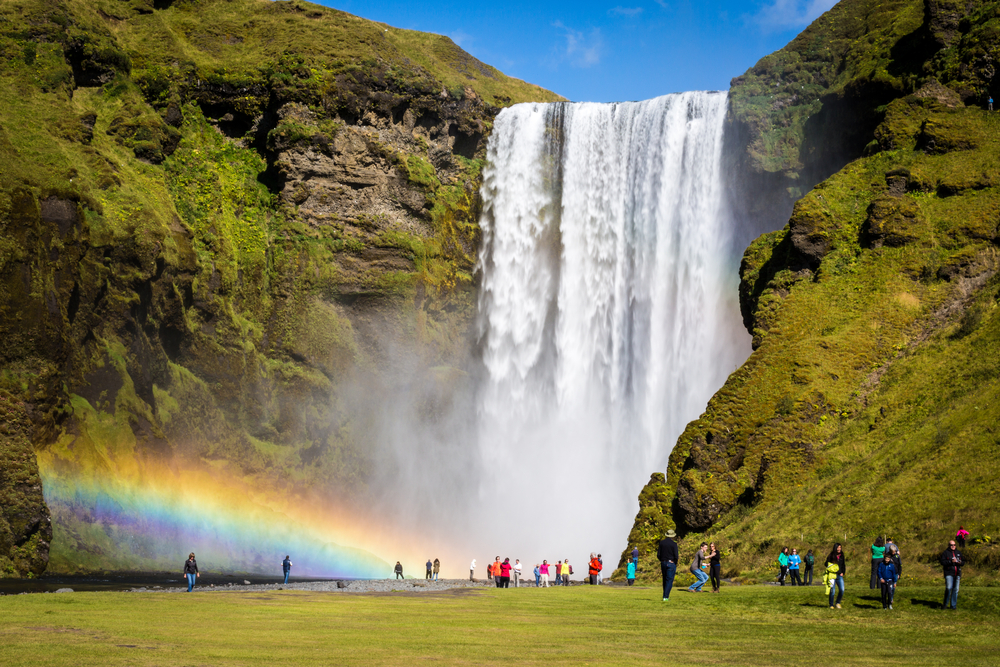
Iceland Weather in September
September still has great sunshine for Iceland, but it does go down to just below 12 hours by the end of the month. It is the warmest month with a chance to see the Northern Lights.
Temperatures are still quite nice, and we are back in shoulder season. This means that you can enjoy the nice weather and decent daylight hours without all the crowds of summer.
By the end of the month the likelihood of snow increases. If you visit Iceland in September , you will want to pack your warm clothing!
Iceland Weather in October
October in Iceland is still technically part of the shoulder season, but it is starting to feel much more like the low season of winter. Daylight is down to about 8 hours a day.
In addition, the average temperature is dropping back down to about 41 ° F. While it is not absolute winter yet, the weather should be taken into consideration at this point.
Bring warm clothes and waterproof ponchos. October is the wettest month in Iceland with an average of 14 days with precipitation.
Although it is colder, October is the best time to visit Iceland if you want to explore with as few crowds as possible. The roads are still open and you can still go pretty much everywhere you want.
Iceland Weather in November
Welcome to winter and the off-season in Iceland. November begins the coldest time of the year, although December and January are colder. This is when the snow starts to fully cover the island.
The average temperature is 38 ° F, but it can get much colder. Daylight only lasts about six hours.
We love to visit Iceland in the low season, and really do think it is one of the best times to visit Iceland. You just have to be prepared for the lower temperatures and the weather.
Iceland Weather in December
The last month of the year is one of the coldest months, second only to January. Temperature highs only reach about 39 ° F. It gets as cold as 21 ° F.
In addition, Iceland in December sees quite a lot of precipitation and snow. Daylight hours are generally pretty short.
However, this does make it and January the best time to visit Iceland for the Northern Lights! However, it is also the cloudiest month, meaning the lights can get obstructed.
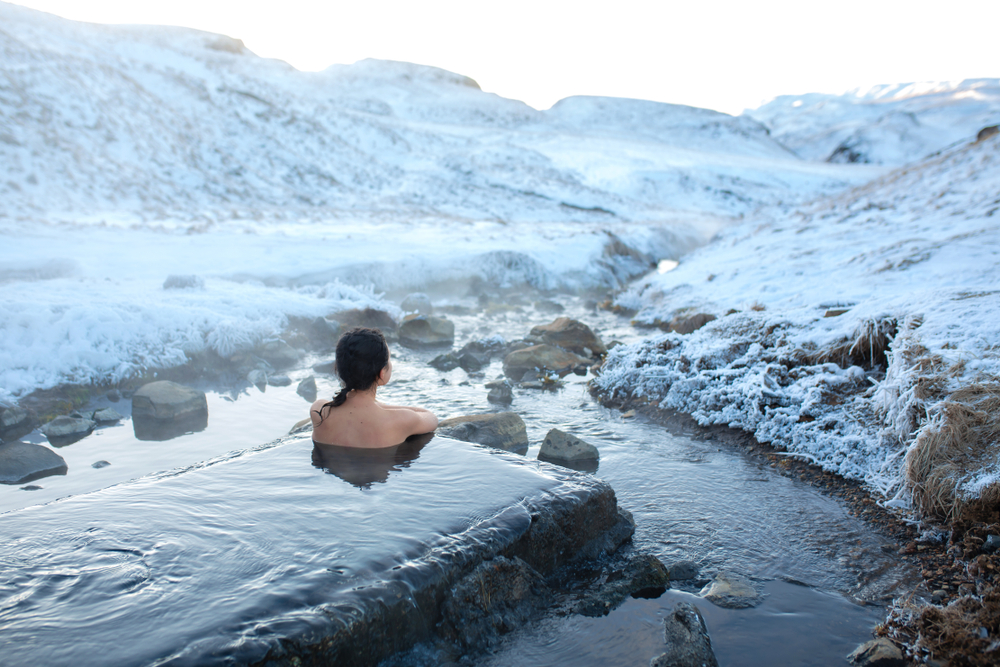
Iceland Events and Activities by Month
While the weather is a big deal, sometimes it is not as important as what you can do. After all, most weather is survivable if you plan and dress accordingly.
If you are more curious about what is going on than what temperature it will be, we have you covered! We have broken down the events and activities you can do during each month of the year.
You might be surprised by some of your options, especially during the winter!
Iceland in January
Can you even go wrong with New Year’s Eve when you are celebrating in a different country? Especially Iceland!
The country takes this holiday seriously with partying on New Year’s Eve, sleeping on the first, and shopping on the second.
And then there is Christmas–that is right, Christmas extends into January in Iceland, with the last day being on the 6th. If Christmas is your favorite holiday, then the end of December and the beginning of January is definitely the best time to visit Iceland.
Another great January tradition in Iceland is Thorrablot . This pagan celebration was canceled when Iceland went Christian but has had a resurgence in the last couple of centuries.
It is a week-long celebration of an Icelandic tradition that will not disappoint. If you want to feel like a local, prepare yourself for some things you have never eaten before, like rotten shark meat, boiled sheep’s head, and congealed sheep’s blood.
Iceland in February
February is beloved for the Winter Lights Festival . As a celebration of bright and happy things, you will love the way they light the streets with brilliant fluorescence to chase the darkness of winter away.
Öskudagur is basically Icelandic Halloween. The kids dress up in great costumes, and instead of the “trick or treat” chant, sing for their candy.
The Icelandic Food and Fun Festival is a fantastic festival that celebrates Icelandic cooking. And not even the kind that uses blood and rotten shark meat! It is all about using ingredients native to Iceland and enjoying all the culinary joys the country has to offer.

Iceland in March
Did you know that Iceland had its own prohibition period? Beer with an alcohol level of over 2.2% was banned for the majority of the 1900s but legalized again in 1990.
Iceland celebrates this legalization with the unofficial holiday, Beer Day, on the first of March every year! We think you can probably guess what the main activities are. (Drinking beer.)
DesignMarch is similar to the Food and Fun Festival in that it is a celebration of Icelandic creativity. The event features purely Icelandic products and goods.
Continuing in a similar fashion, the Reykjavik Folk Festival honors centuries of traditional music and song.
Iceland in April
Iceland celebrates Easter for days just like Christmas. Honestly, we do not know why more countries do not do holidays like this! Celebrating with just one day is so minimal!
Easter lasts from Holy Thursday to Easter Monday in Iceland. It is generally spent with family, rather than with huge parties.
April’s other holiday is the first day of summer. Given the dark of winter and the light of summer, and the very small in-betweens, Iceland actually does not traditionally recognize spring and autumn as seasons. So summer starts in April!

Iceland in May
The Reykjavik Art Festival is a big deal in May! People come from all over the world to participate in and experience creativity and fun.
If art is not your thing, May still might be the best time to visit Iceland with the Rite of Spring Festival. We know, we know, we just told you there is no spring in Iceland.
But when Iceland gave up its traditional calendar, they adopted spring and autumn into their new calendar. And they like to welcome spring with heartfelt jazz and folk music!
Iceland in June
It should come as no surprise that a country that willingly eats rotten shark meat celebrates the sea! Iceland’s Festival of the Sea happens in June, and it honors the country’s long tradition of seafaring.
Iceland also celebrates its independence from Denmark every June 17th. Like the 4th of July in the United States, Iceland National Day is a country-wide affair filled with parades, concerts, and general enjoyment of Icelandic culture.
Summer Solstice takes advantage of the Midnight Sun with all-night rock concerts. You can also join the locals in watching the sun set and rise all within the course of 2-3 hours.
Another unique Iceland festival is the International Viking Festival . It is a days-long holiday event that pays tribute to Iceland’s fierce Viking history.
Iceland in July
Innipukinn Festival is another music festival that happens in July. If you are not already getting the sense that you can hit up a music festival basically anytime you visit Iceland, well, you can. Icelandic people really love their music, okay?
They mix things up a bit with LungA , a festival specific to the Icelandic town of Seyðisfjörður . This festival still has music (as any good festival does) as well as art!

Iceland in August
Verslunarmannahelgi–say that five times fast, we dare you! Honestly, if you can pronounce it once we will be impressed. Verslunarmannahelgi happens the first weekend of August and is a quick bank holiday (kind of like Labor Day in the US). People generally celebrate by going camping.
Gay Pride comes the second weekend of August, and nowhere celebrates it as Reykjavik does! With parades, parties, and concerts, this is truly a vibrant and fantastic event.
If you like running, (like, really like) then the third weekend of August is the best time to visit Iceland! This is when the Reykjavik Marathon occurs, and it is another event that attracts people from all over the world!
The marathon wraps up with Menningarnott , a fantastic cultural celebration with cultural events, fireworks, and you guessed it, great music!
Iceland in September
The capital city of Reykjavik has two festivals in September, making it the best time to visit Reykjavik if you are wanting to have some fun during the shoulder season.
First is the Reykjavik International Literary Festival . This one is not just a big deal to Iceland, it is actually the biggest literary festival in Northern Europe!
Next is the Reykjavik International Film Festival . There is just something about literature and film that make them go hand in hand. Both of these festivals draw people from all over the world, but especially the film festival!
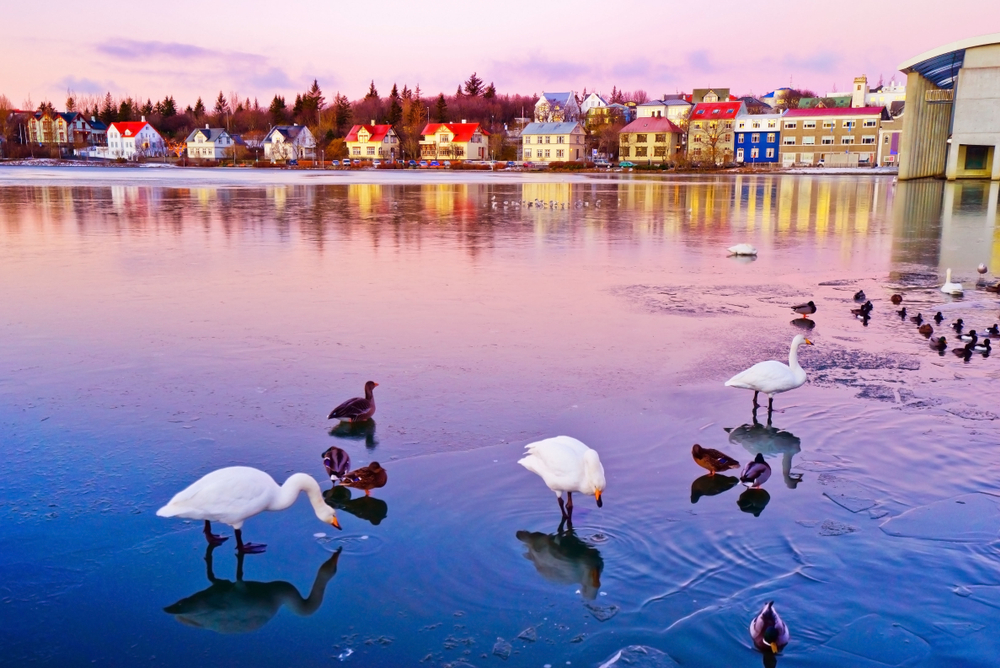
Iceland in October
Iceland Airwaves is another music festival but centers on indie and alternative music rather than the traditional folk and rock music of so many other festivals. Of course, folk and rock music still abound!
Iceland also celebrates Halloween in October, although they have not been celebrating it as long as other countries and do it a little differently. It is more of an adult holiday, but still features costumes!
Iceland in November
November does not have a whole lot going on in the realm of festivals and events. What it does have, though, it makes sure to do well.
Frostbiter is Iceland’s Horror Film Festival. So while Iceland does not have much going on in November, it is still the best time to visit Iceland if you love horror!
Iceland in December
Sorry not sorry, but Iceland has the best Christmas lights. Seriously, you have to check them out! Because the country is so dark all the time in December, they go all out with the Christmas lights.
And the way they make such a contrast against the dark? Unbeatable.
Everything about Iceland Christmas is simply unbeatable. From the concerts to the food to the country’s own unique and fun traditions, you will absolutely love it.
New Year’s Eve is filled with fireworks, bonfires, and singing. There are even costumes!
And they do not wrap things up and go to bed at midnight. Iceland New Year partying lasts long into the early hours of the next day.
December is the best time of year to travel to Iceland if you love all the December holidays!
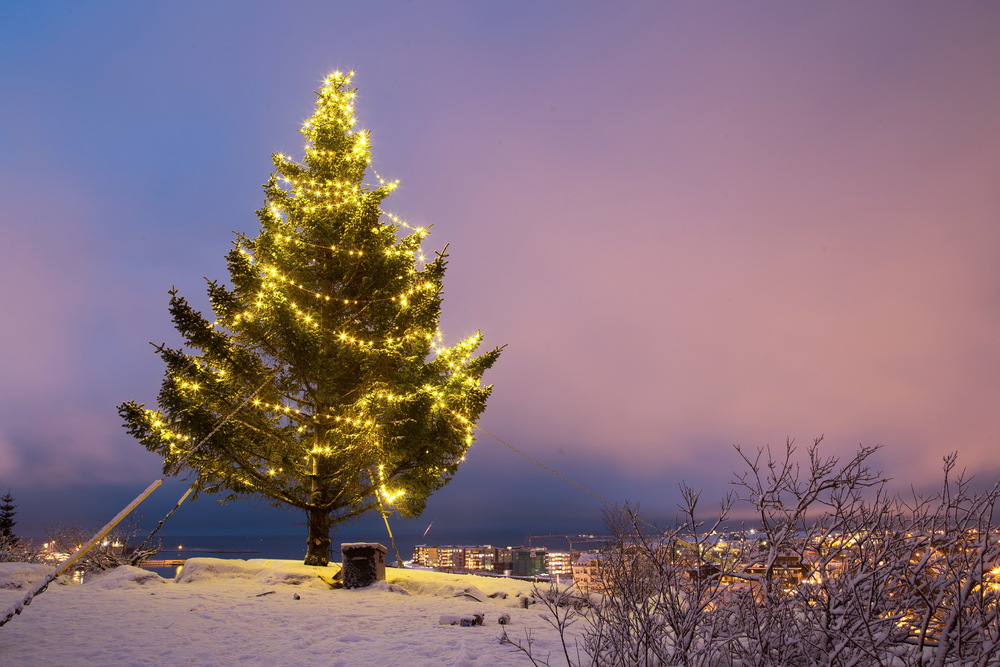
When is the Worst Time to Visit Iceland?
Honestly, there is really no bad time of year to visit Iceland as long as you plan accordingly. After reading this article, you should have a good idea of what each month has to offer in terms of weather, natural events, and festivals.
As long as you visit when you want to and pack according to the season , you will be in Iceland at the right time.
If you want to see the Northern Lights, summer is the worst time to visit Iceland. But, if you want clear roads for your rental car and warm weather, then winter is the worst time to visit.
So, When is the Best Time to Visit Iceland?
At the end of the day, the best time to visit Iceland is 100% up to you! Whatever your interests are and your budget will determine when you should visit this amazing country.
After all, this is your trip to Iceland. Plan it around what you want to see and do.
Do you want the midnight sun and purple, lupine flowers? Come during summer. Hate crowds and overpaying, but want decent weather? Give shoulder season a try. Does your Iceland bucket list involve the Nothern Lights or ice caves? Winter is your best bet!
Iceland is gorgeous year-round, and you really cannot go wrong no matter when you visit!

We hope our guide to the best time to visit Iceland has been helpful! Feel free to let us know when you decide to go in the comments below. What is your favorite time to travel to Iceland?

Reader Interactions
Leave a reply cancel reply.
Your email address will not be published. Required fields are marked *
Save my name, email, and website in this browser for the next time I comment.
When is the best time to visit Iceland in 2024?
Mar 7, 2024 • 5 min read

Summer is the best time to take an Iceland road trip © Klaus Vedfelt / Getty Images
There’s no such thing as the perfect time to visit Iceland as the weather is notoriously whimsical and the best season for your trip depends entirely on what you want to experience.
Mid-summer is glorious with eternal daylight courtesy of the midnight sun. This is the time for hiking, camping and exploring the wilderness, and when most services are open. The down side is many destinations will be packed with tourists.
We've got all the information you need about the highs and lows of different seasons. Whenever you choose to visit Iceland, pay attention to forecasts and road conditions and follow any safety advice issued by Icelandic authorities .
December to January is best for seeing the Northern Lights
Christmas lights brighten up the darkness and a festive spirit is in the air as the dark season nears its peak. Frost glitters and snow transforms landscapes into winter wonderlands. Christmas markets are held in Heiðmörk outside Reykjavík, in Hafnarfjörður and on Ingólfstorg square in Reykjavík, which has the added bonus of an ice rink. If conditions are right, the first ski resorts open up.
The sparse daylight means that you have a better chance of seeing the Northern Lights, especially outside populated areas where there is less light pollution (find a Northern Lights forecast here ). Joining tours is advisable. While it is possible to drive yourself, road conditions are often slippery and snowstorms are common.
Festivals worth checking out in winter include Dark Music Days and þorrablót mid-winter feasts, celebrated around the country. For the brave, restaurants often serve special þorri food.

February to March is the best time for snow sports and hot springs
It’s still dark and cold so communities brighten up the darkness with events like the Winter Lights Festival in Reykjavík and List í ljósi festival in Seyðisfjörður in the East. In narrow fjords in the Eastfjords and Westfjords, inhabitants celebrate the return of the sun with sólarkaffi and have pancakes. Snow sports become more enjoyable as daylight gradually returns.
Spring is an abstract concept in Iceland as the weather doesn’t always play along. It can still be cold and snowy, but the days get longer and the sun sometimes shines on skiers – this is often the best time for snow sports. The first of the migrant birds arrive and slowly but surely, nature springs back to life. Around Easter, events like Easter egg hunts are a fun family activity. In Ísafjörður, the Aldrei fór ég suður music festival is held and Ski Week is around the same time.

April to May is the best time for off-peak travel
While the weather is still unreliable, temperatures gradually rise. The first flowers blossom and trees bud. Migrant birds arrive in flocks and lambs and foals are born. Migrant whales have also returned and with better weather, whale watching is more enjoyable. The bird-watching season begins, although some areas may be closed due to nesting.
There are relatively few tourists around and if conditions are good, this can be a good time for a road trip . Look out for off-season discounts on accommodation and activities. However, not all tours and services have opened up yet.
The first Thursday after April 18th is the official First Day of Summer in Iceland, which is celebrated with parades and events around the country – even though the weather rarely plays along.
June to August is the best time for outdoor recreation
While there’s no good weather guarantee, this is your best chance of sun and warmish temperatures. Late June to early August is when most Icelanders go on vacation, filling up campgrounds wherever the best weather is forecast. This is the height of the tourist season – and height of the whale-watching season – so whatever you have planned, it’s best to book ahead.
Expect crowds at the most popular destinations, like on the South Coast and the Golden Circle . But as it’s bright all night, you can beat the crowds by traveling either super early or late. In July, Highland roads open up, but you'll need to book a tour or hire a 4WD vehicle equipped for F-roads and crossing rivers (if that’s your plan). Summer is the best season for hiking, biking and horseback riding. Around mid-August, wild berries ripen.
Summer is also festival season. Fishermen’s Day is a national celebration held in every seaside town on the first weekend of June. Around June 21, summer solstice is celebrated on Grímsey island, Iceland’s northernmost inhabited island. The Reykjavík Arts Festival is held every other year – the next one is on in June this year (2024).
Bræðslan music festival is held in Borgarfjörður eystri on the last weekend of July. Verslunarmannahelgi is a weekend in August that is packed with festivals and events, and Reykjavík Pride has various events held throughout the city, culminating in the Pride Parade.
Reykjavík Culture Night and the Reykjavík Marathon are held on the third weekend of August.

September to November is best for cultural events
Nights grow colder and camping is no longer advisable as fall rolls into winter. The weather is often good, though, so hiking can still be enjoyable. Pay attention to weather forecasts and bring warm clothing. Nature starts to change colors, painting forests and heather yellow, orange and red. Þingvellir National Park is at its most beautiful.
Road tripping is still possible and there will be fewer travelers around. However, winter is around the corner, so roads get slippery as soon as the temperatures drop and conditions can get stormy.
Réttir sheep and horse roundups are held in the countryside, and the Reykjavík International Film Festival takes place in the capital. In East Iceland, the Days of Darkness festival is held around Halloween and the Iceland Airwaves music festival is held in Reykjavík. Advent is approaching and Christmas preparations begin. This is a great time for visiting galleries and museums, going to concerts, relaxing in heated swimming pools, and feasting on good food.
This article was first published Feb 18, 2021 and updated Mar 7, 2024.
Explore related stories

Jan 2, 2023 • 12 min read
Want to start planning for the year ahead? Featuring sports events, natural phenomena and more, these are 20 amazing trips to consider taking in 2023.

Apr 6, 2024 • 3 min read

Mar 31, 2024 • 12 min read

Mar 31, 2024 • 6 min read

Mar 30, 2024 • 4 min read

Mar 28, 2024 • 17 min read

Mar 12, 2024 • 8 min read
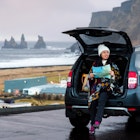
Mar 6, 2024 • 9 min read

Mar 4, 2024 • 10 min read

Feb 19, 2024 • 7 min read
Welcome back sun!
As winter snows melt away, Norway bursts to life with vibrant colours, the scent of cherry blossoms, surging waterfalls, and sun-hungry Norwegians enjoying the outdoors. Embark on picturesque hikes through lush forests, explore quaint villages, and see newborn lambs in the meadows. Norway's springtime beauty promises the rejuvenation and renewal we all need after a long winter. Book your getaway now and get ready to be enchanted by the wonders of spring in Norway!
Hot – hotter – hottest!
Norwegian summer is here – get ready for a magical season! Experience lazy days exploring the coast by boat and cosy small towns in the south, stunning UNESCO-listed fjords and majestic mountains in Fjord Norway and long summer evenings under the midnight sun in Northern Norway. Whether you are seeking thrilling outdoor adventures, peaceful moments in nature, or culinary experiences, Norway's summer promises an unforgettable escape.
Read more about the summer season .
Golden hues and crisp air
Witness the amazing transformation of nature into brilliant red, orange, and yellow colours. Sample the culinary delights of the season, vibrant city life, and hiking in the mountains with the best views. Traveling off-season brings plenty of benefits: more space, fewer queues, and a more personal welcome!
Read more about autumn in Norway .
Step into a winter wonderland
Embrace the beauty of winter in Norway. Whether you're seeking adventure, relaxation, or a getaway in breathtaking nature, Norway in winter promises memories that will warm your heart for years to come. Book your winter adventure to Norway now and create memories that will last a lifetime!
Read more about the winter season .
Discover more
Take advantage of top offers.
See our selection of trusted companies that work hard to make you happy all through your trip.
Your recently viewed pages
- Privacy & disclosure policy
- Portfolio & Press
- NORWAY ITINERARIES
When is the Best Time to visit Iceland? [Month-by-Month]
Psst! Some links in my posts may be affiliate links, which means that I get paid a fee if you chose to purchase something through it. This doesn't cost you anything, but makes a huge difference for me! Thanks for your support!
Want to know when is the best time to visit Iceland before you book your getaway? And more specifically, which are the best months to go?
You are in the right place!
With its active landscapes, friendly locals and once-in-a-lifetime experiences, Iceland is one of many people’s top bucket-list destinations to visit. But like most places, each season brings a completely different experience.
To make sure you don’t miss out on the most amazing trip to Iceland, let’s take a look at the best times to book a getaway here. By the end of this guide, I’m sure you will have found the perfect time of year to visit Iceland for you.
Table of Contents
Quick Iceland Travel Guide
Where to stay : Most people visiting Iceland stay in Reykjavik, as it is the main hub and largest town on the iceland. It is also where most tours depart from. Classic hotels include the Hilton Reykjavik and the Hotel Reykjavik Saga , but for a more budget-friendly option you’ll find that people are renting out their homes ( this one has a car included! ) and apartments .
Top activities and tours in Iceland :
- Golden Circle & Blue Lagoon
- Glaciers & Waterfalls Tour
- Whale Watching
- Reykjavik Local Food Tour
- Northern Lights Photography Tour
Packing for Iceland : The time of year you visit will affect your packing list. If you are visiting in winter, I have covered everything you need in this guide . In the warmer months, you still need to keep in mind that the weather can change quickly, and it can get chilly in the evenings. Layers is always key, and a light puffer jacket such as this one should be with you year-round when visiting the Nordics.
Getting from the airport : The airport in Reykjavik (located in the smaller town of Keflavik, and named thereafter, KEF) is about 50 km/31 miles from Reykjavik. You can easily book a bus transfer in advance , taking you to the Reykjavik city center (where most hotels are within walking distance). For an even more hassle-free arrival, book a private transfer .
When is the best time to visit Iceland?
You can visit Iceland any time of year and have an amazing time. No matter the seasons, there are plenty of things to do in Iceland to keep you busy. But when you visit does depends on what you want to do with your time here.
Some experiences can only be done during certain months of the year in Iceland. If you are desperate to catch a glimpse of the Northern Lights , go on a whale watching trip or have the ultimate winter escape, you are limited to only a few weeks of the year.
To help you out, here are some of the most popular times to visit Iceland , depending on you preferred activity :
- For Winter Activities : November
- For The Northern Lights: January
- For Driving: May
- For Sight-Seeing: September

When Is The Best Time To Visit Iceland: Season by Season
Below is a detailed breakdown covering when is the best time to visit Iceland based on season. Like with the rest of Scandinavia, some seasons are short whilst others (here’s looking at you, winter) are longer than elsewhere.
A little further down, I have broken down the best time to visit Iceland for specific activities and interests, such as northern lights or whale watching (or just to avoid crowds).
Iceland’s Autumn: September to October
Autumn in Iceland, from September to October, offers a tranquil and picturesque experience with mild weather, breathtaking landscapes, and fewer crowds compared to the peak summer season. It’s an ideal time for nature lovers, photographers, and those seeking a more intimate connection with this enchanting island.
Similar to how Autumn is my favourite time of year to visit Norway , it is a great season in Iceland too!
Iceland’s Weather in Fall:
- Temperatures : The temperatures during the autumn months hover around 5-10°C (41-50°F), providing a comfortable environment for outdoor adventures.
- Precipitation : Rainfall is relatively moderate, with occasional bursts of showers. Be prepared for changing weather conditions and have waterproof gear handy.
The best activities to do during this season are the Golden Circle Tour, hiking, photography and the Iceland Airwaves music festival.
If you have a car, don’t miss this self-drive Golden Circle Tour you can download to your smartphone ($40). If you are without a car , this guided tour takes you around the Golden Circle in a day ($129)!

Iceland’s Winter: November to March
Iceland transforms into a winter wonderland from November to March. While the weather can be challenging, there is nothing like experiencing an Icelandic winter experience!
Weather in Winter:
- Temperatures : Winter temperatures typically range from -1°C to 3°C (30°F to 37°F) along the coast, but it can be colder inland and in the highlands.
- Daylight Hours : The days are short, with only a few hours of daylight.
The best activities to do in winter are to see the northern lights , ice caving and glacier hikes.
Make sure to pack well if you are visiting in winter. My packing guide for Norway in winter will also be of great help if you are visiting Iceland during the cold months.
If you are visiting for the northern lights, my #1 tip is to book a tour with a northern lights guarantee , and book it for one of your first nights in Iceland. Basically, this means that if you don’t see any northern lights (for example if the sky is overcast or there isn’t any northern lights activity), you are automatically booked in for a new tour later on your trip.
Read next : how to take photos of the northern lights with an iPhone
⭐️⭐️⭐️⭐️⭐️ This is the highest-rated northern lights tour from Reykjavik, with photos included and a northern lights guarantee (make sure to book in advance)!
Iceland’s Spring: April to May
This season offers a delightful blend of milder weather, budding landscapes, and brighter days, making it an excellent time to explore this Nordic gem. Reykjavik starts to come alive, and those going on a road trip can explore some of the island’s Viking symbols and key Viking locations .
Weather in Spring:
- Temperature : Spring temperatures in Iceland range from 3°C to 10°C (37°F to 50°F), providing a welcome thaw from winter’s chill.
- Daylight Hours: As spring goes on, daylight hours increase significantly, perfect for long days of exploring.
The best activities to do in Iceland’s spring period are volcano tours, snorkelling, horse riding and visiting the outdoor hot springs such as the famous Blue Lagoon.
Iceland’s Summer: June to August
Iceland’s summer, from June to August, is a magical time to visit. The country is under the Midnight Sun during these months, one of the things the Nordic countries are famous for .
So visitors are offered extended daylight hours and milder weather, making it the perfect season for exploring breathtaking landscapes and enjoying endless outdoor activities.
If you are visiting Iceland in the early summer, you’ll love seeing how dramatic the waterfalls are. Some of the best waterfalls in Iceland are at their most spectacular at this time.
Weather in Summer:
- Temperature : Summer temperatures in Iceland generally range from 10°C to 15°C (50°F to 59°F), but can occasionally climb higher.
- Daylight Hours : One of the highlights of summer is the Midnight Sun, with almost 24-hour daylight, especially in June.
The best things to do during Iceland’s summer are whale watching , kayaking, puffin watching and local food tours .

The Best Months To Visit Iceland To See The Northern Lights
The Northern Lights phenomena are probably why a lot of people book a winter trip to Iceland. However, this rare experience can be hard to track down, especially if you do not visit during the right months.
In this post I have broken down all the criteria you need to have checked off in order to see the northern lights.
To get a better chance of seeing the Northern Lights during your trip, book between January and March . During these months you will still have shorter daylight hours, leaving you more opportunities to find them. And if you want to make sure you see them during your trip, consider booking a Private Northern Lights tour!
The extended darkness, stable weather, increased solar activity, fewer crowds, and the unique winter ambience combine to make it the absolute best time to chase the Northern Lights in this captivating Arctic wonderland.
Below are some of the highest rated Northern Lights tours in Iceland (both private and in groups).
The Best Time To Visit Iceland For Whale Watching
Between April and September is the absolute prime time to see whales in Iceland, all though you can see them year-round.
Humpback whales, orcas, and even the elusive blue whales make their appearances in the water around this time of year.
Also, you have to keep in mind that most whale-watching tours only operate during the summer season (except for the one linked below). In the winter, the tours will give you thermal jackets and jumpsuits to bundle up in, but I always recommend wearing wool as your inner layer regardless.
Booking a whale watching between April and September means you have plenty of tour options to choose from, as there are more tours operating then.
With favourable weather, an abundance of whale species, a variety of tour options, and the bonus of stunning birdlife and the midnight sun, these months are ideal for any whale watching adventure.
⭐️⭐️⭐️⭐️⭐️ This is the original whale watching tour from Reykjavik, and has been given Viator’s Badge of Excellence (must be booked in advance)!
The Best time to visit Blue Lagoon In Iceland
This geothermal wonderland is at its absolute best in the summer months (from June to early September). Even though it’s magical to visit any time of year, the Blue Lagoon is at its peak during the summertime.
The midnight sun means you can capture the Blue Lagoon’s beauty at all hours, and is a great chance to take some amazing photos of your visit. However, as this is a pretty popular time to visit, it’s recommended to book your visit during the morning or evening. This experience is so much better when it’s not crowded!
The summer months are also an amazing time to book some incredible Icelandic tours because you get to see so much more thanks to the good weather and extended daylight hours. Just remember to book in advance as they can sell out quickly.

What Is The Best Month To Go To Iceland To Avoid Crowds?
If you’re seeking to experience the beauty of Iceland without the hustle and bustle of crowds, consider planning your visit during the shoulder seasons of April-May or September-October . During these months, the tourist numbers are notably lower compared to the summer peak season.
In April and May, Iceland has milder weather and the winter conditions are melting away. It’s an excellent time to explore the stunning landscapes and enjoy attractions with fewer visitors and at cheaper prices.
September and October bring a different charm, as fall conditions are still around with their vibrant colors. The weather remains pleasant and there is still a lot of daylight hours.
By choosing these shoulder seasons, you can explore its iconic sights at a more relaxed pace, making it the perfect choice for those looking to avoid the crowds while still enjoying all that Iceland has to offer.
When Is The Worst Time To visit Iceland?
While Iceland is undoubtedly a captivating destination year-round, there’s one period that many travelers might want to think twice about: the worst time to book a trip to Iceland, for most, would be during the winter months, specifically from late November to early February.
Some adventurers revel in the winter wonderland that Iceland becomes during this time of year. However, it’s good to know the challenges that come with a winter visit here.
Winter in Iceland can be pretty brutal. The country lives up to its name with fierce winds, biting cold, and unpredictable storms. It’s not uncommon for roads to close, making travel between towns and tourist attractions challenging, if not impossible. The harsh conditions can turn even short drives into arduous journeys. This is why it’s important to get your hire car through a reliable company , pay attention to road conditions and listen to locals’ advice.
Basically, all the things I tell you to do if you are going on a road trip in Norway .
Side note : this Iceland road trip itinerary is not to be missed if you are planning on a self-drive adventure!
Short days are another downside of winter in Iceland. In December, the sun can rise as late as 11:00 AM and set as early as 3:30 PM. This means you’ll have very limited daylight to explore the stunning landscapes, making it difficult to fit in all the sights and activities you might have on your itinerary.
It’s also important to keep in mind that many outdoor activities that make Iceland famous become tricky during winter.
Hiking trails become treacherous, waterfalls may freeze, and some natural wonders are inaccessible due to road closures or extreme weather conditions. Activities like glacier hiking and ice cave tours can be done, but they come with added safety precautions.
Accommodation prices can also be relatively high during the winter season, primarily because of those seeking a cozy escape from the cold. Booking your place to stay in advance is always a good idea when visiting Iceland, especially in Winter.
The Best Months To Visit Iceland FAQs
I’m sure you have a few more questions you need to answer before clicking on that Book Now button. To help you out, here are the most commonly asked questions about the best times to visit Iceland:
When Is The Best Time To Visit Reykjavik?
The best time to visit Reykjavik, Iceland, is during the summer months, from June to August. This period offers the mildest weather, extended daylight hours for exploration, and a vibrant cultural scene. It’s ideal for outdoor activities and enjoying the city’s festivals and events.
What are the cheapest months to visit Iceland?
Visiting Iceland during the shoulder seasons of April to May or September to October can be a budget-savvy choice. Accommodation and tour prices are generally lower than during the peak summer months. You’ll still enjoy relatively mild weather, fewer crowds, and the chance to witness Iceland’s natural beauty without the huge costs.
When Is The Peak Season In Iceland?
The peak travel season in Iceland typically spans from June to August. During these summer months, the country experiences milder weather, extended daylight hours, and vibrant green landscapes. This makes it the most popular time for tourists to explore Iceland’s natural wonders!
What Month Is Rainy In Iceland?
Iceland experiences relatively consistent rainfall throughout the year. However, if you’re looking for the wettest months, they tend to be in the late autumn and early winter, with October and November being some of the rainiest months in Iceland. It’s worth noting that Iceland’s weather can be unpredictable, so be prepared for rain at any time during your visit.
What Is The Stormiest Month In Iceland?
The stormiest month in Iceland is typically January. During this winter month, the country often experiences powerful storms characterized by strong winds, heavy snowfall, and challenging weather conditions.
Is It Better To Go To Iceland In April Or May?
April has slightly lower temperatures but offers the chance to witness lingering winter landscapes. May is milder and greener, with longer daylight hours, making it suitable for outdoor activities. Both months are excellent, so it ultimately depends on whether you prefer a winter wonderland or a more spring-like experience.
The Best Time To Visit Iceland Final Thoughts
Each season in Iceland offers its unique charm and activities. From the endless daylight and outdoor adventures in the summer to the magical Northern Lights in the winter, Iceland has something to offer year-round.
Whether you want to hike, go whale-watching, or soak in geothermal pools, there’s never a wrong time to explore this remarkable country!
Unfortunately, there are some activities you can only do at certain times of the year. So if you want to experience the Northern lights and winter activities, plan your trip for January. For those who want to see nature in full bloom, the summer months are the perfect time to visit.
No matter when you decide to visit Iceland, you will have an amazing time. Just remember if you are visiting in their peak seasons, book your tours, transport and activities in advance.
Where is Tenerife Island?
Visiting the norwegian fjords in the winter, you may also like, punta cana vs cancun: which destination is best..., the best month to visit punta cana, dominican..., do you need a passport for punta cana, punta cana diving (my experience + helpful tips), the 5 best punta cana excursions, how to be a tourist in norway, 10 ridiculous questions tourists in norway have *actually*..., how to plan a trip to norway [a..., 5 fun things to do in oslo with..., top things to do in oslo, norway [a..., leave a comment.
Save my name, email, and website in this browser for the next time I comment.

The Best Time to Visit Norway Explained (Pros and Cons of Each Season)
The climate in Norway changes a lot between each season, and a visit in the middle of summer will be a very different experience compared to a visit during the winter. So when exactly is the best time to visit Norway?
The best time to visit Norway depends on what you want to do. If you want to experience the hiking trails, natural wonders, tourist attractions and warm weather, summer or early autumn is best. If you instead want to experience the amazing skiing opportunities, the northern lights or the cold snow, winter is the best time.
Some people also prefer the shoulder season in spring or autumn due to cheaper prices on accommodations and less crowds at the tourist attractions.
So before you plan when to visit Norway, you should ask yourself what exactly you want to experience when you are visiting. Let’s take a closer look at what each season in Norway is like to make your choice a bit more well-informed.

Spring in Norway: Sunny, but chilly days with snow in the mountains
We regard March, April and May as the official spring months in Norway , and this is actually a very nice time to visit.
Some of the benefits of visiting during the spring is that you will be able to experience all the good thing about the winter by going up to the mountains, while the lowlands will be more temperate, and you can safely be outside without freezing too much.
The weather in spring can be very changing , from sunny and 15 C one day to close to freezing degrees and lots of rain the next. The early spring can also have some snowfall, but this will usually lead to lots of melted snow, and not a real layer of snow that covers the ground.
The farther north you are, the more like winter the spring will feel like. Places like Tromsø or Lofoten is still very wintery in March and April, and will have plenty of snow cover.
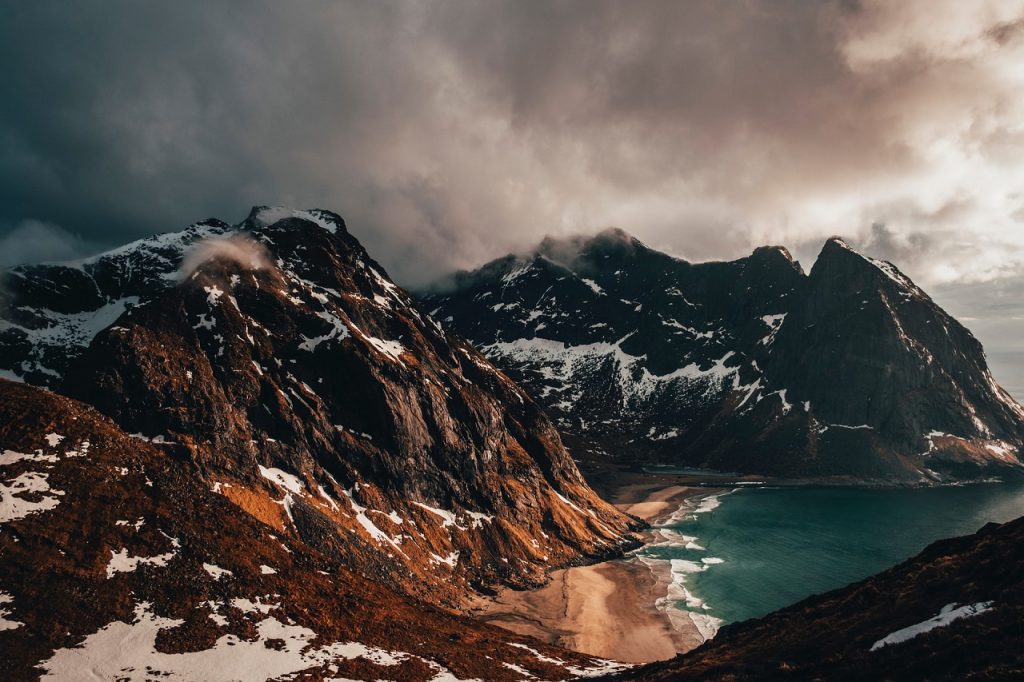
If you want to go skiing or take a hike in the snow, go to the mountains to designated skiing villages like Geilo or Valdres. There are plenty of places with snow during early spring, and there are many different skiing villages where you can go skiing until pretty much the start of summer.
You will need to bring warm clothing if you visit Norway during the spring , but if you’re lucky you might not need to use your jacket at the middle of the day. Be aware that it tends to rain a lot during spring, so always bring waterproof shoes and a waterproof jacket with you.
The end of spring will also include May 17th, the national day in Norway . This is a very cool and unique experience where you get to see a completely unique part of Norwegian culture. This 1-day event is a huge celebration that you are guaranteed to remember for the rest of your life !
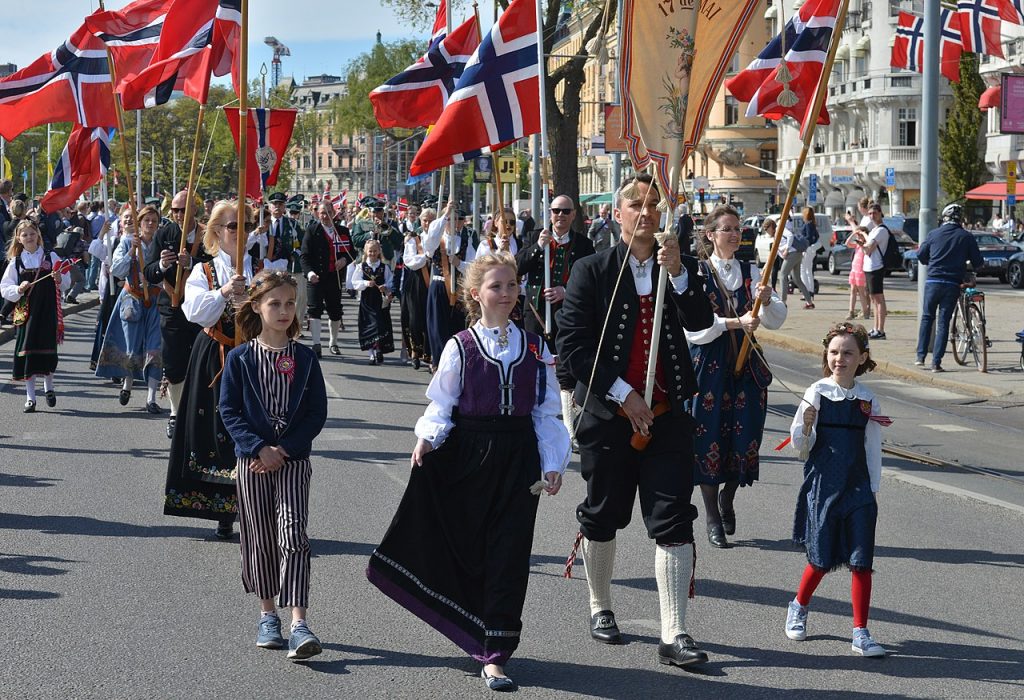
Some of the downsides to visiting Norway during the spring is that there is still a lot of snow in the mountains, and most hikes are pretty wet to say the least. You might not be able to use all the hiking trials just yet, but many of them will be ready, especially later in the spring.
You will generally not be able to complete hikes like Pulpit Rock, Trolltunga or Kjeragbolten without special hiking equipment in the early spring, since there will be many areas with partial snow or ice cover.
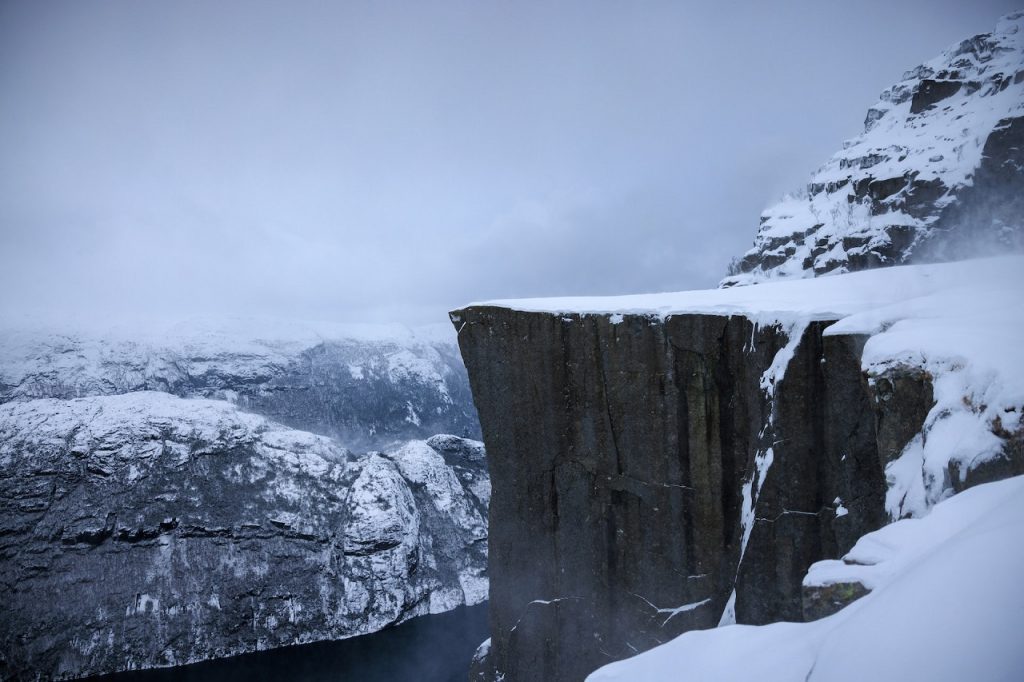
Summer in Norway: Norway’s High Season
I love the Norwegian summer, and I would advise everyone to come to Norway during the summer. The temperature is usually pretty warm in the early 20s (70 F), so it’s not too warm, but also not too cold.
The summer in Norway allows you to do most of the common tourist stuff, and it is the most popular season for both Norwegian and foreign tourists . All the hiking trials are open, and many things like museums and zoos are only open during the summer. This allows you to do most of the things Norway has to offer.
It is also possible to swim at the beaches during summer , and the water can reach pretty nice temperatures. There are many good beaches in Norway, and it’s definitely not too cold for a day at the beach when the sun is out.

The summer allows for camping in the wilderness, long days with a sun that never sets, swimming in the fjords, or going on hikes to natural wonders.
All the incredible Norwegian waterfalls like Vøringsfossen or Kjosfossen are at their best behavior with the most water flowing, so they are all worth stopping by.

If you want to experience the snow, skiing or things like that, then the summer is obviously not your best choice. There might be a few areas with snow if you go hiking up high in the mountains, but most of Norway is completely free of snow during the summer.

Autumn i Norway: A bit chilly, but absolutely beautiful
The autumn start at the beginning of September, and this marks a pretty big change in the Norwegian weather. The warm summer evenings will quickly be changed into cold gusts of wind that makes the air very refreshing and nice .
You will have to bring a jacket with you for most of the autumn, but there are occasionally hot days as well where you can enjoy the autumn sun. If you don’t mind the chilly air, a visit to Norway in the autumn can make for some incredible experiences!

I would say that early autumn is a good time to visit Norway . Most Norwegians are back at work, school has started for the children, but the weather is still pretty nice, and you can still experience most of what Norway has to offer, but with many fewer tourists, so it won’t feel as crowded.
Some of the downsides to visiting at autumn is that there is a lot of rain , and you might get very unlucky and get 4 -5 days in a row with heavy rainfall.
Norwegians typically know how to dress for these autumn days, so take a look at what they wear, and try to copy it. You will want to always bring some extra clothes , because the weather can get from nice and sunny to cold and rainy very fast!
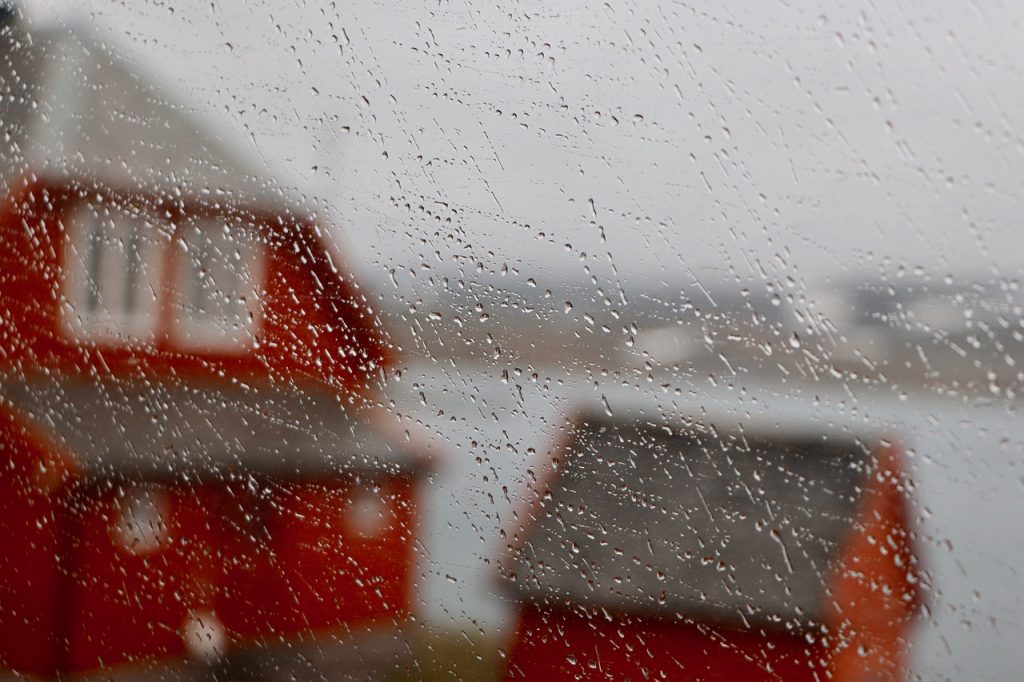
It is usually not very snowy in most parts of Norway during the autumn, and there might not be much real snowfall until late November . Last year’s snow has long since melted, and it’s bare in most of the country. So autumn is terrible choice if you want to go skiing.

Winter in Norway: The Incredible Winter Wonderland
The winter in Norway is unique, and a very different experience for people that are used to living further south . Many people think of Norway as a frozen wasteland, and this might be somewhat true during the winter, especially in northern Norway.
If you visit Norway between December and February, expect a lot of snow, cold weather and icy roads . The days will be very short, and there are only a few hours of daylight at the middle of winter.
It’s generally pretty difficult to drive in the winter with the icy roads, so make sure to bring your winter tires , and be prepared for convoy driving and even closed roads.
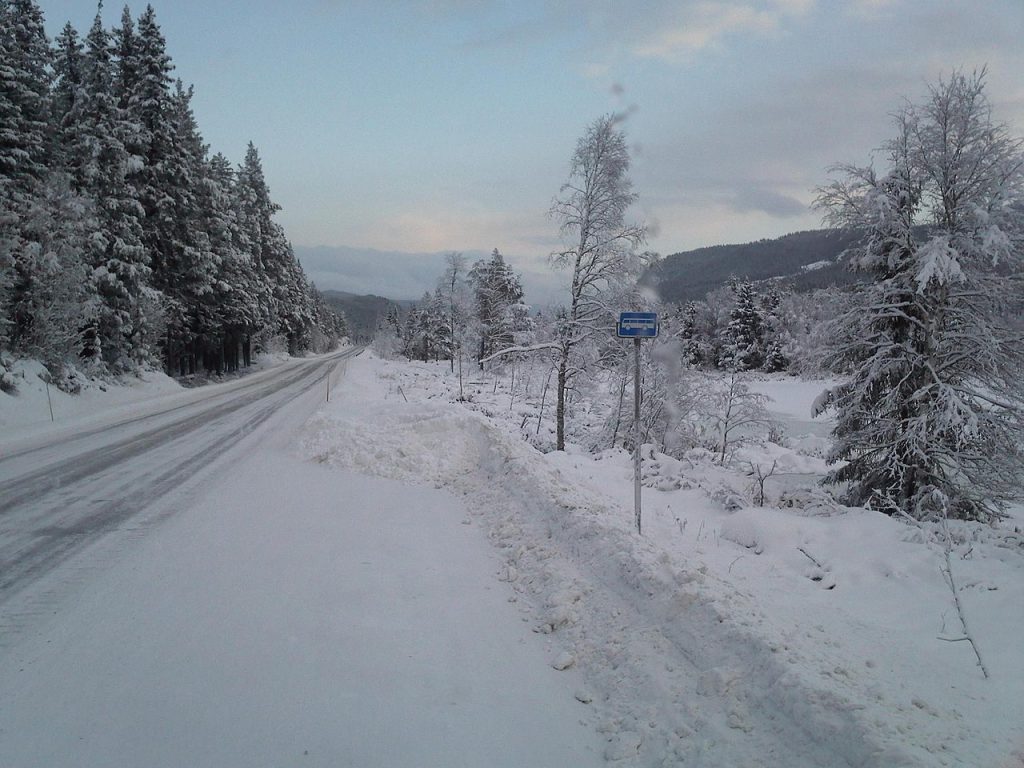
In the far north, there it no sun at all during the winter months. This phenomenon is known as polar nights , and the middle of the days are still covered by darkness. It’s not exactly pitch black in the middle of the day, but it’s more akin to dark twilight.

Visiting Norway during the winter can be a great experience, but tourists tend to bring less clothes than they need. You will need to wear wool under your clothes on cold days if you want to spend time outside .
The temperature can vary very much. Some days the temperatue might linger around 0 degrees, but certain days might be super cold even in places like Oslo . Be prepared for temperatures as low as -20, even though they are pretty rare in the lowlands in the southern part of Norway.

Towns in the mountains, such as skiing villages, will usually see many days with -15 to -25 degrees, so make sure to bring enough clothes if you are going to visit these places during winter.
If you enjoy skiing, then the winter is obviously a good time. Most parts of Norway will be covered in snow during the winter , but there might be certain times when a hot weather streak melts the ice.
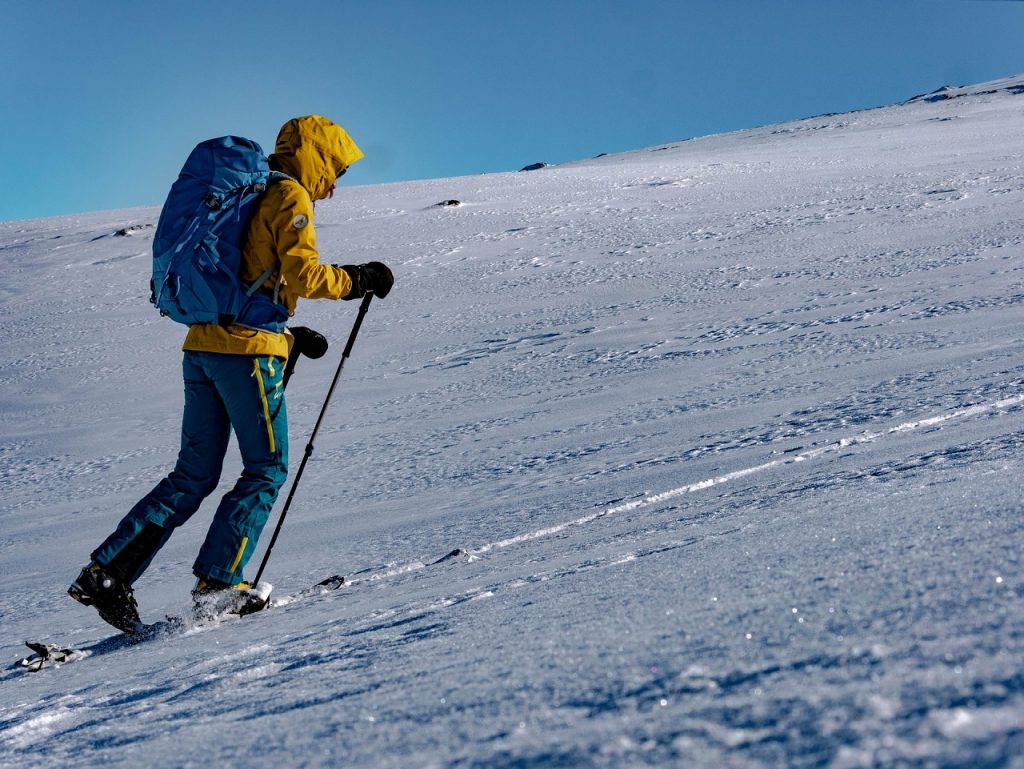
January is generally the best month to visit if you want to experience a lot of snow. And the further north you go, the colder and more snowier does the winter get.
The downside to visiting during the winter is that the lack of sun can make it a bit boring, since you only have a few hours to actually see stuff . This makes it difficult to see some of the natural wonders of Norway, and it can feel pretty boring to travel from place to place since it will usually be dark outside.

Norwegian people also tend to be a little less open to tourists during the winter . People often spend most of their time inside, and don’t really care to stop for a chat outside when it’s cold. So you might feel that people are less open than they are otherwise.
Winter events in Norway
The Christmas Celebration is a big thing in Norway, and takes up pretty much all of December . The first 3 weeks are often super busy for Norwegians, and you will see huge crowds of people shopping, so all the city centers and shopping malls are bustling with life.
There will be lots of Christmas events in all of December, which can be a unique experience that is worth checking out. Christmas decorations will fill up most public places.
The actual celebration begins around December 21 – 23, with the main celebration being on Christmas Eve on December 24.
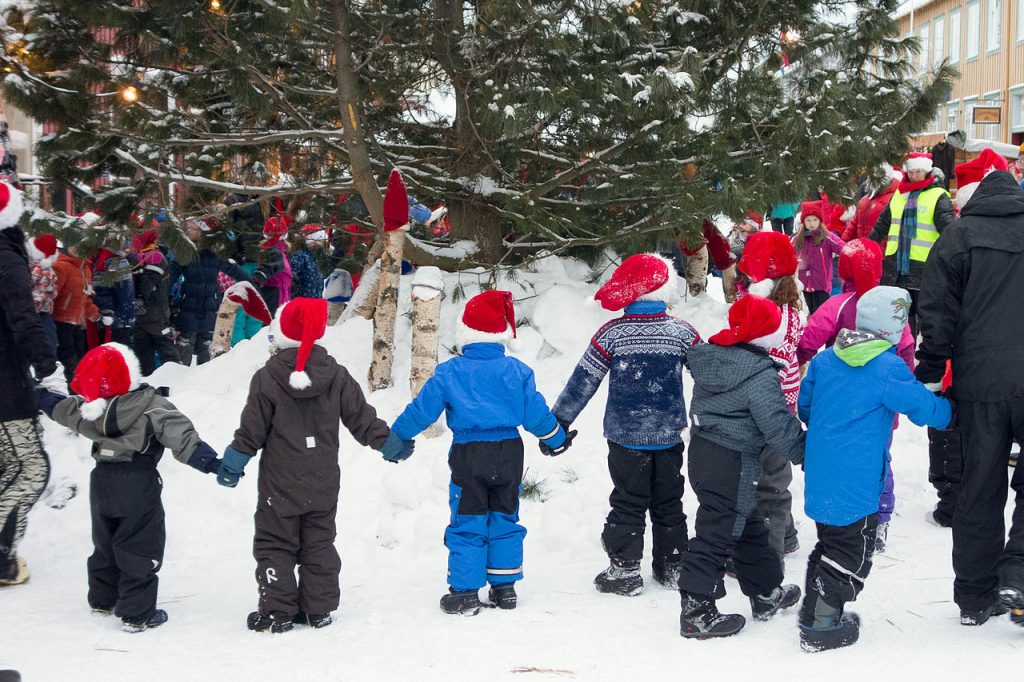
Not only will the Christmas Celebration affect your daily activities as a tourist, but you should also be aware that most shops are closed during the public holidays during Christmas . The same goes for museums and many tourist attractions, so the last two weeks in December will severely impact your visit.
At the same time, it’s something magical about visiting Norway during Christmas , so it’s both a pro and a con.
So when’s the best time to visit Norway?
It is worth keeping in mind that this is only a general summary of each season, and there will obviously be big variations from place to place and from year to year .
I would argue that there is no «best season» for visiting Norway , and each season has both pros and cons. Choose whichever suits you the best, depending on how well you are at dealing with the weather.
Frequently asked questions about the best time to visit Norway
When is the best time to visit norway.
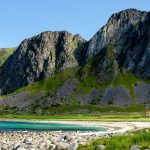
When the best time to visit Norway is truly depends on what you want to do. That said, most tourists visit during the summer. This is when all tourist attractions are open, the weather is at its best, and places like Lofoten, the big cities, the fjord regions and the hikes are most beautiful and accessible.
When is the best time to visit Norway for seeing the northern lights?

The best time to see the northern lights in Norway is during the winter. Anytime from late October to early April has a chance of having the aurora borealis, but the main northern lights season is in December to February .
You will want to travel pretty far north to a city like Bodø, Alta, Tromsø or the North Cape to have a decent chance of seeing the aurora, even though it’s possible to catch the northern lights in Oslo a few times each winter .
When is the best time to visit Norway for snow?
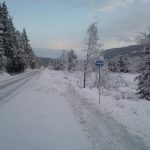
The best time to visit Norway to be guaranteed snow is December to March for northern Norway or in mountain regions , or January to February for anywhere in the lowlands south of Trondheim .
There will usually be snow outside of these time periods as well, but it’s not guaranteed since the days in March can have really warm weather that melts the snow (temporarily) in southern Norway.
When is the best time to visit Norway for seeing the fjords?

If you’re coming to Norway to see the incredible fjords on the western coast, then you want to visit in summer . This is when the fjords are at their best, and there are no less chance of roads being closed due to weather. Many hotels, campsites and attractions near the fjords are only open during the summer season.
The spring and autumn season are also pretty amazing, but they have a high chance of raining. And when it rains it pours in western Norway, so bring waterproof clothing and your umbrella if you’re visiting the fjords in spring or autumn.
When is the best time to visit Norway for a road trip?

The best time to visit Norway for a road trip is probably in the late spring, summer or early autumn. This is when the roads are best to drive, and you can freely drive in the country without having to fear roads that are closed due to storms, winter closed roads, convoy driving or icy roads.
Many roads, including famous tourist roads like Trollstigen, are not open at all during winter or early spring before the snow melts .
When are most tourists visiting Norway?

Norway’s main tourist season is in the middle of summer in June and July . This is true for both international tourists as well as Norwegian tourists. August is fairly popular as well, but not as popular as June or July is.
When is it cheapest to visit Norway?
The cheapest time to visit Norway is generally in the shoulder seasons in early spring or late autumn .
Leave a Comment Cancel reply
Save my name, email, and website in this browser for the next time I comment.
When To Visit Norway: A Monthly Guide
.webp)
If you're thinking about visiting Norway and wondering when is the best time to go, we've got good news for you! This Scandinavian country has something special to offer in every season.
From magical winter wonderlands with Northern Lights displays to long summer days with never-ending sunlight, Norway is a destination that can be enjoyed all year round.
To help you plan your trip, we've put together a list of what you can expect in Norway each month, along with some exciting events and festivals that are worth attending. Start planning your Norway trip with this guide and get ready for an unforgettable adventure in one of the most beautiful countries in the world!

Best Time to Visit Norway
Don’t have time to read the whole article? No worries! To help you plan your trip, here are the most popular activities in Norway, along with the best months to visit.
Whale Watching: Late October to mid January
Northern Lights: November to February
Midnight Sun: Typically from June to July
Road Trips: April to early September
Hiking: May to September
Camping: April to September

Weather in Norway by Month
This guide can help you plan your trip to Norway accordingly and make the most of your visit. We've listed what to expect in Norway by month, as well as the major events. It's always a good idea to check the weather forecast and book your accommodations ahead of time, especially during peak tourist seasons.
.webp)
January is one of the coldest months in Norway. During this month, you can expect snow almost everywhere. With an average daylight of 6 to 7 hours, January is one of the best months to view the northern lights.
You can also enjoy many snow activities in the mountains, such as skiing and dog sledding. Except for ski resorts and ice hotels in the snow, January is a slow season with lower prices and fewer crowds. As the coldest and darkest month of the year, January has a unique beauty that can only be experienced during this time.
Events: Northern Light Festival , Tromso International Film Festival

February in Norway is usually a bit brighter and has longer days than January but it still is another cold month in Norway. Despite the colder temperatures, February is still a great time to visit, as there are plenty of outdoor activities that can be enjoyed, including viewing the northern lights.
February in Norway is still the low season, so you can take advantage of lower rates and fewer crowds for another month.
Events: Ice Music Festival , Kristiansund Opera Festival , PolarJazz Festival , Sami Week

March has plenty of festivals to enjoy. It is still considered an off season month in Norway, but the days start to become noticeably longer and temperatures begin to creep up a bit, making it a great time for outdoor activities. During this month, there are more daylight hours to enjoy winter sports.
You can enjoy lower rates and fewer crowds in March until the end of the month, when spring breakers begin to arrive. It is also the last chance to see the northern lights before they disappear until autumn.
Events: Narvik Winter Festival , Winter Chamber Music Festival , Stavanger Vinfest , Holmenkollen Ski Festival
.webp)
As the weather warms and nature begins to bloom, spring arrives in Norway, making it an ideal time to explore the country. The weather in the north is still cold, but it warms up later in the month. While the rest of the country enjoys longer daylight hours and temperatures ranging from 4 to 9 degrees Celsius.
April is considered shoulder season in Norway, so you can enjoy fewer crowds and lower rates. It is also one of the best months to cruise the Fjords. It is important to note that some businesses may be closed during Easter.
Events: Voss Jazz festival , Inferno Metal festival
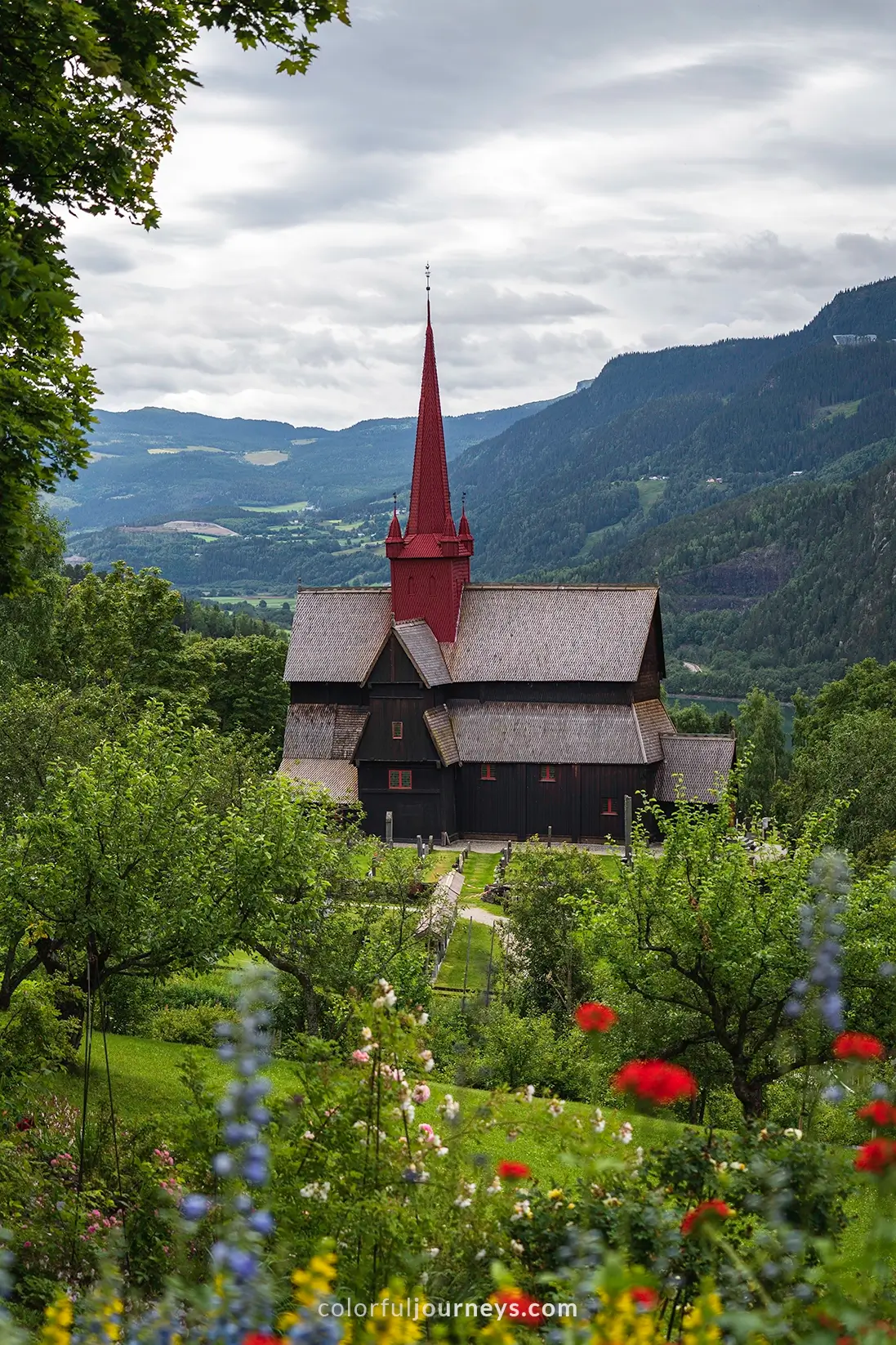
May is an excellent time to visit Norway before the summer crowds arrive, as most tourist attractions still have lower prices and fewer visitors. Spring is in full bloom, and you can look forward to warmer weather and longer days.
The weather in May is also known to be extremely unpredictable, so expect some days to be rainy and others to be warm and sunny. May is an excellent month for hiking, and waterfalls are in full flow due to melted snow. On the 17th, you can also join the locals in celebrating Norway's National Day.
Events: Bergen International Festival , Mai:jazz, Stavanger International Jazz Festival

June in Norway is the beginning of the summer months, offering the perfect opportunity to experience all that this picturesque country has to offer. With warmer weather and longer daylight hours, you can enjoy a variety of outdoor activities such as hiking, cycling, and camping.
In June, there are numerous outdoor and music festivals to attend. The great weather also brings more crowds, so expect higher prices this month for most activities, accommodations, and attractions. Head up to the north to experience the midnight sun in Norway.
Events: Extreme Sports Festival , Overoslo Music Festival , Færderseilasen Race , Risør Kammermusikkfestival

The busiest time of the year in Norway is in July. With the warm temperatures and long hours of daylight, many people choose to take their holidays during this time, including the Norwegians. As a result, long lines at popular attractions and higher prices are to be expected.
In July, daylight lasts around 16 to 18 hours, perfect for enjoying the outdoors. July is also an excellent month for island hopping, fjord cruising, and hiking. Tourists visiting Norway during this month can expect days filled with festivities and breathtaking views of the midnight sun around the arctic circle.
Events: Gladmat , Riddu Riđđu Festival , Arctic Sea Kayak Race , Kongsberg International Jazz Festival

August marks the end of the summer season in Norway but it is still considered a high season, so prices remain high. However, you can expect smaller crowds at the main tourist attractions compared to July. During this month, you can still enjoy pleasant temperatures and many sunny days.
However, expect unpredictable weather in the north and prepare for some rainy days. With plenty of sun lasting 14 to 16 hours, August is still a great time to visit and enjoy the outdoors. Such as hiking, camping, and the numerous festivals that take place throughout the month.
Events: Bergen Beer Festival , Norway Seafood Festival , Pstereo Music Festival , Skalldyrfestivalen

September marks the beginning of autumn. It is a great time to visit if you want to avoid the summer months while still enjoying longer daylight hours. Expect the weather to be cooler in the early mornings and evenings, so bring some warm clothing with you.
If you enjoy hiking or camping, September is an excellent month to avoid crowds. Just be prepared for the unpredictability of the weather and expect some cool wind or rain. You need to plan ahead when visiting in September as some popular attractions may be closed and tour availabilities are limited.
Events: Bergen Food Festival , Oslo Marathon

The month of October in Norway is ideal for viewing the autumn foliage. October sees fewer travelers due to the cooler weather and shorter days, so you can expect a quieter and less expensive travel experience compared to the peak season. The northern lights will begin to appear in the Arctic Circle as the days become shorter.
However, Norwegian autumns are known to be very unpredictable. As a result, expect cloudy and rainy weather in October. We recommend checking the weather forecast for the area you're visiting ahead of time and bringing warm and waterproof clothes.
Events: Lillehammer Jazz Festival , Insomnia Festival
.webp)
November in Norway is the last month to see the last fall colors. This is typically a slow month with fewer visitors because summer vacationers have long since left and winter travelers have yet to arrive.
You can expect warmer weather in the south and winter-like conditions with freezing temperatures in the north. Remember to bring warm clothing, as well as rain and snow-resistant walking shoes.
Because there are fewer daylight hours in November, you have a good chance of seeing the northern lights. It's also a great month for other winter activities like skiing and dog sledding in the north.
Events: Rakfisk festival
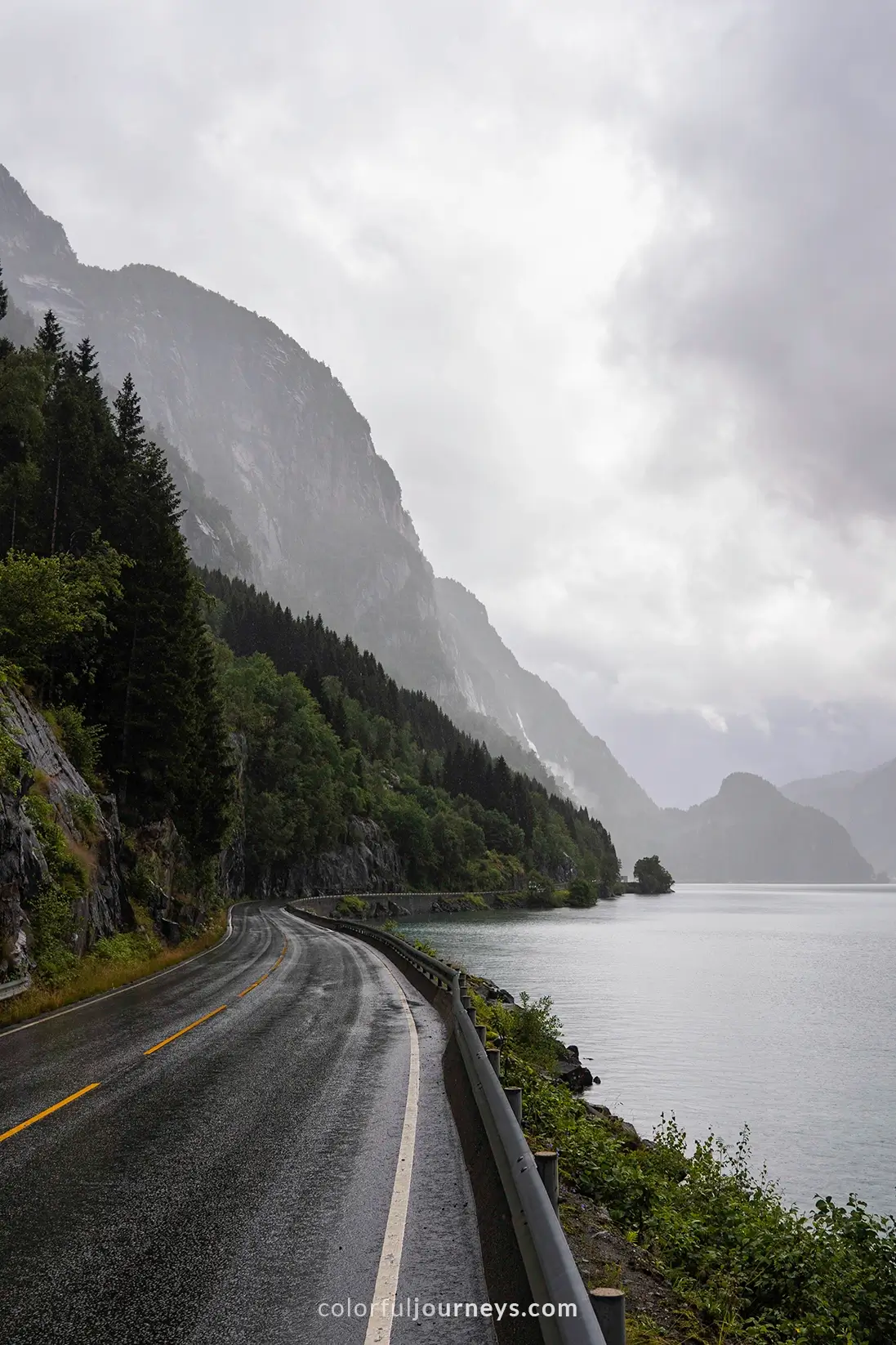
While December is a very busy month for Norwegians, it is slightly less busy for tourists. It is a great time if you want to experience the Christmas spirit, as the villages and cities have a festive atmosphere as they get ready for the holidays.
December is also one of Norway's coldest months, with 5 to 6 hours of daylight in the south and polar nights in the north. That means there's a good chance you'll see the northern lights in December. Just remember to bring warm clothes and be prepared for rain that can turn to snow. Other December activities include a whale safari, ice skating, reindeer sledding, and many more.
Events: Røros Christmas Market , St. Lucia Day
.webp)
And that's the guide to the best times to visit Norway, as well as a monthly guide to what you can expect.
Norway is a beautiful country, and visiting during any month of the year promises a unique and unforgettable experience. With a variety of activities available all year, Norway has something for everyone, and you're sure to have a great time.
Some links in this Norway guide may be affiliate links.
This means that if you make a purchase after clicking on one of our links, we will receive a small commission at no extra cost to you. Please know that by doing so, you are supporting Colorful Journeys in continuing to provide free high quality content to help you in your travels!

Share this article
Related posts.
.webp)
Guide to Driving the Atlantic Ocean Road in Norway
Looking to drive the Atlantic Ocean Road in Norway on your own? Here is a guide that includes the best time to drive, things to do, photography tips, and more!
.webp)
A Guide to Lovatnet Lake in Norway
Visit Lovatnet Lake, also known as Lake Loen, one of the most breathtaking lakes in Norway using this complete guide for first-time visitors.
.webp)
Visiting Briksdalsbreen Glacier in Norway
Here is a complete guide to the most popular glacier arms to visit in Norway - Briksdalsbreen Glacier! Find out when to visit, best way to reach the glacier, troll car and hiking information, and many tips to help you plan your trip.
Thanks for visiting nordicvisitor.com! For the very best browsing experience on our website, we urge you to upgrade to the most recent version of your browser . Some of our site features may not function properly on older versions.
- Travel Update
- Search Suggested Results View All Results
- EUR (€)
- GBP (£)
- Self-Drive i
- Privately Guided i
- Guided Small Groups i
- Northern Lights i
- Honeymoon & Romance i
- Ice & Snow Hotels i
- Multi-Country Tours i
- All Travel Styles
- Show all tours
- Best Sellers
- Special Offers
- Scandinavia
- Switzerland
- United Kingdom
- Book With Confidence i
- Why book with us i
- Booking Terms i
- Sustainability Policy i
- Manage Booking
- Privacy policy
Iceland Bíldshöfði 20 110 Reykjavík +354 578 20 80 View Map
Sweden Scotland View Details
When is the Best Time to Go and Visit Norway?
When planning a Scandinavian getaway you might find it important to know when is the best time to visit Norway. The truth is that this beautiful Nordic nation is a worthy travel destination year-round, so it’s hard to go wrong!
Having said that, each season has its own unique benefits. The summer is perfect for fjord cruises and road trips. The winter is the ideal time to spot the northern lights and take part in snow-based activities.
To learn more about the best time to go to Norway, read this guide to the 4 seasons followed by our travel experts’ answers to frequently asked questions.
You’ll know what to expect at each time of year, what activities are best as well as when and where to go in Norway for your ideal trip.
- Explore these summer tours of Norway to find the itinerary that’s perfect for you
- Or browse winter trips for an adventurous Nordic getaway
- Visit Norway in summer
- Visit Norway in autumn
- Visit Norway in winter
- Visit Norway in spring
- Going on an adventure to Svalbard
- Travelling along the Norwegian fjords
- Taking advantage of the best weather
- Visiting the capital Oslo
- Journeying north to Tromsø
- Discovering Ålesund
- Combining Norway with Sweden and Denmark
- Admiring the northern lights
- Visiting both Norway and Iceland
- Wandering around Bergen
- Touring onboard a cruise
- Hiking in the beautiful landscape
- Enjoying the midnight sun
- Going whale watching
- What to pack for your trip to Norway
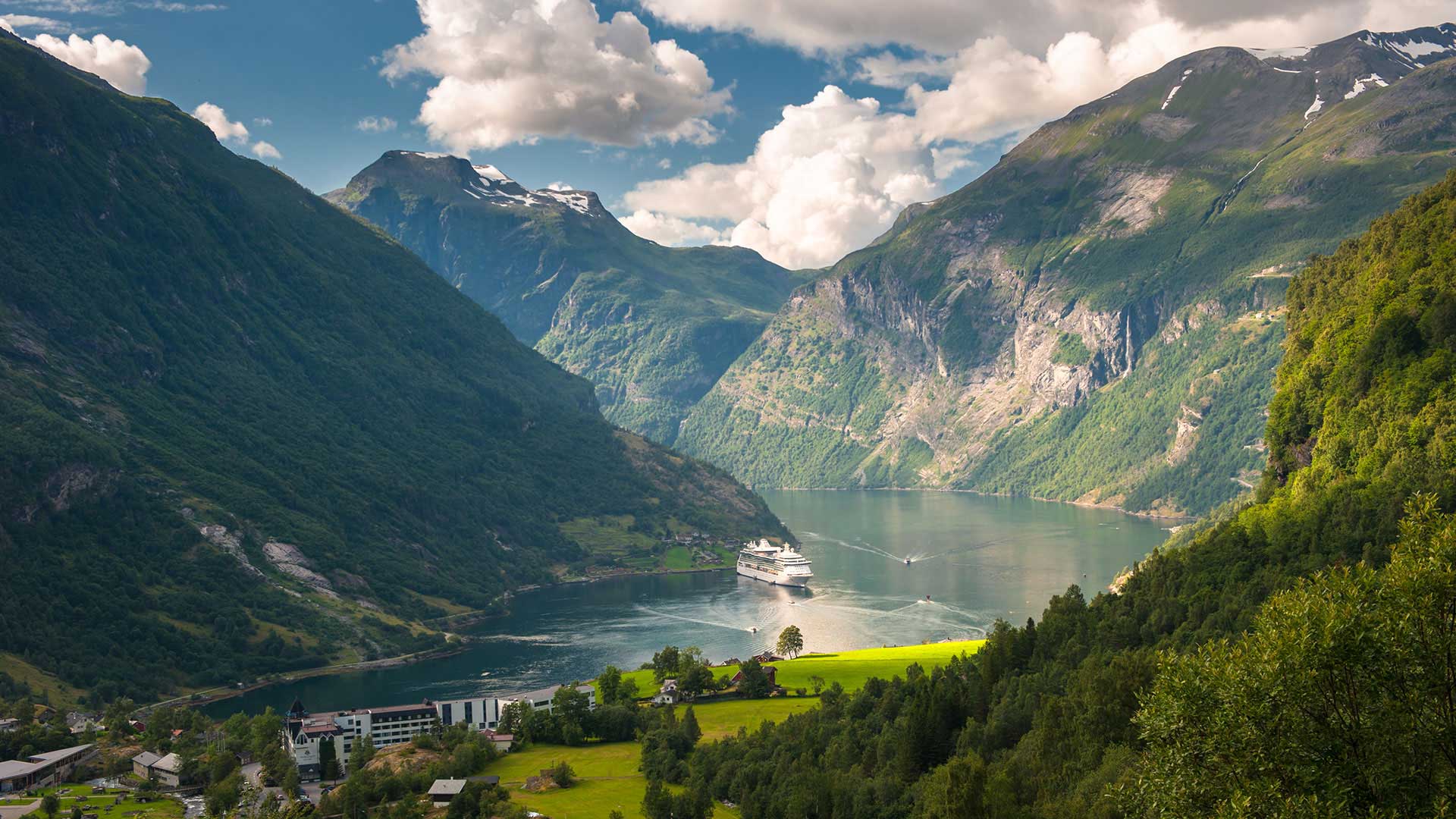
Norway in summer
Best for enjoying the midnight sun & warm waters
June to August is a fantastic time to visit Norway if you want to take advantage of the country’s legendary midnight sun. At this time of year, the days are long and pleasant, and greenery stretches as far as the eye can see.
How’s the weather?
While temperatures in the north (for example in Tromsø) stay low at around 11°C (52°F), temperatures in the south climb into the 20s°C (68°F +). Perfect summer temperatures to enjoy sightseeing.
Best places to visit
The warm weather, endless daylight hours, and good road conditions mean it’s a perfect time for taking on a road trip ! You could leave from the capital, Oslo, and head toward the western fjords region.
Make sure to stop by the famous and UNESCO World Heritage-listed Geirangerfjord .
If you’re keen to venture into the real north of Norway, summer is a good time to go if you want to avoid the coldest, snowiest weather.
We especially recommend touring the Lofoten islands , just north of the Arctic Circle. This charming archipelago is an idyllic place to enjoy nature, hike, kayak, cycle, boat and fish to your heart’s content. Just drink in the astonishing scenery under the midnight sun.
- Look up summer self-drive tours of Norway
- Or take up the epic Norway in a Nutshell ® train and cruise itinerary
Fun activities to do
The warmer weather of the summer means the lakes warm up nicely, making them ideal for wild swimming. Even if you don’t take to the water yourself, you can still make the most of the weather. How abouta boating or kayaking trip?
If you’re in Bergen, you could try the Mt Ulriken zipline. This would allow you to experience the city from a different perspective.
And if you’re a lover of birds, it’s a great time to come to Norway for birdwatching. There are interesting safaris available at this time of year. We can suggest the one in Honningsvåg, in the north of Norway.
Mark your calendar for these fun summer events:
- Riddu Riđđu, an international indigenous festival hosted in July each year. It takes place in Kåfjord, 2 hours outside Tromsø in Northern Norway.
- The Norwegian International Film Festival happens every August in Haugesund, 2 hours outside Stavanger.
- Midnight Sun Marathon is held in Tromsø each June.
- Norwegian Wood, one of Oslo’s best music festivals, also happens to be scheduled for June.
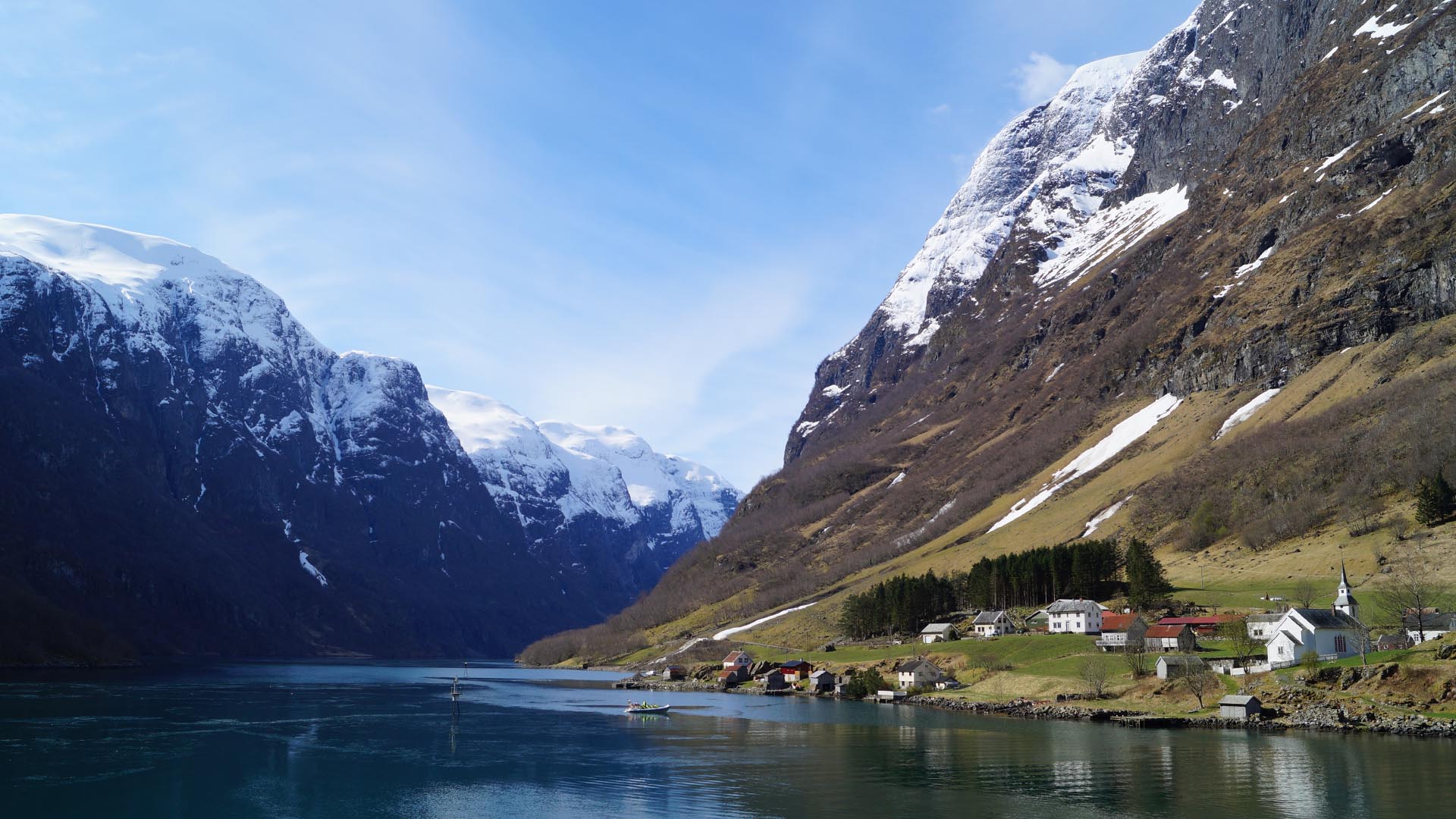
Norway in autumn
Best for enjoying crisp nights & scenic hikes
Between September and November , Norway is transformed. The lush greens of the summer have been replaced with the fiery autumnal shades of yellow, orange and red. At this time of the year, the landscape is on the cusp between colourful foliage and the frost of first snow.
This is the perfect time of year if you enjoy hiking, and especially if you are seeking a quieter ambience. October and November in particular see a drop in visiting travellers, meaning you’ll have more of the sights to yourself.
This is the time of year when the weather in Norway starts to change as the winter approaches. In Oslo, average temperatures come down to around 6°C (48°F) in October, while in the north they are only around 2°C (35°F).
The cities are must-sees during this season as you have plenty of places to visit, such as museums and attractions. You could make your way between Oslo and Bergen, taking on the iconic Norway in a Nutshell® journey.
Going through the country toward the west coast is an ideal way to spot all the gorgeous landscapes, marked by the colours of autumn.
If you’re looking for a fantastic wildlife experience, make sure to head north, maybe on a Havila or Hurtigruten cruise all the way to Kirkenes . This is a good time of year to spot sea life, such as humpbacks and orcas, in the chilly northern waters.
The crisp weather of autumn means it is a great time if you love hiking and are always seeking an interesting viewpoint.
In September and October, you could take on famous hikes to Pulpit Rock , or even Trolltunga. That said, we recommend following local safety advice and weather warnings when out hiking.
You can’t think of the Norwegian autumn without of the aurora borealis. This time of year is the start of the season for going on northern lights tours in Norway .
Mark your calendar for these autumnal events:
- Bergen International Film Festival held at the end of September.
- Dark Season Blues, a music festival held in Longyearbyen in Svalbard each October.
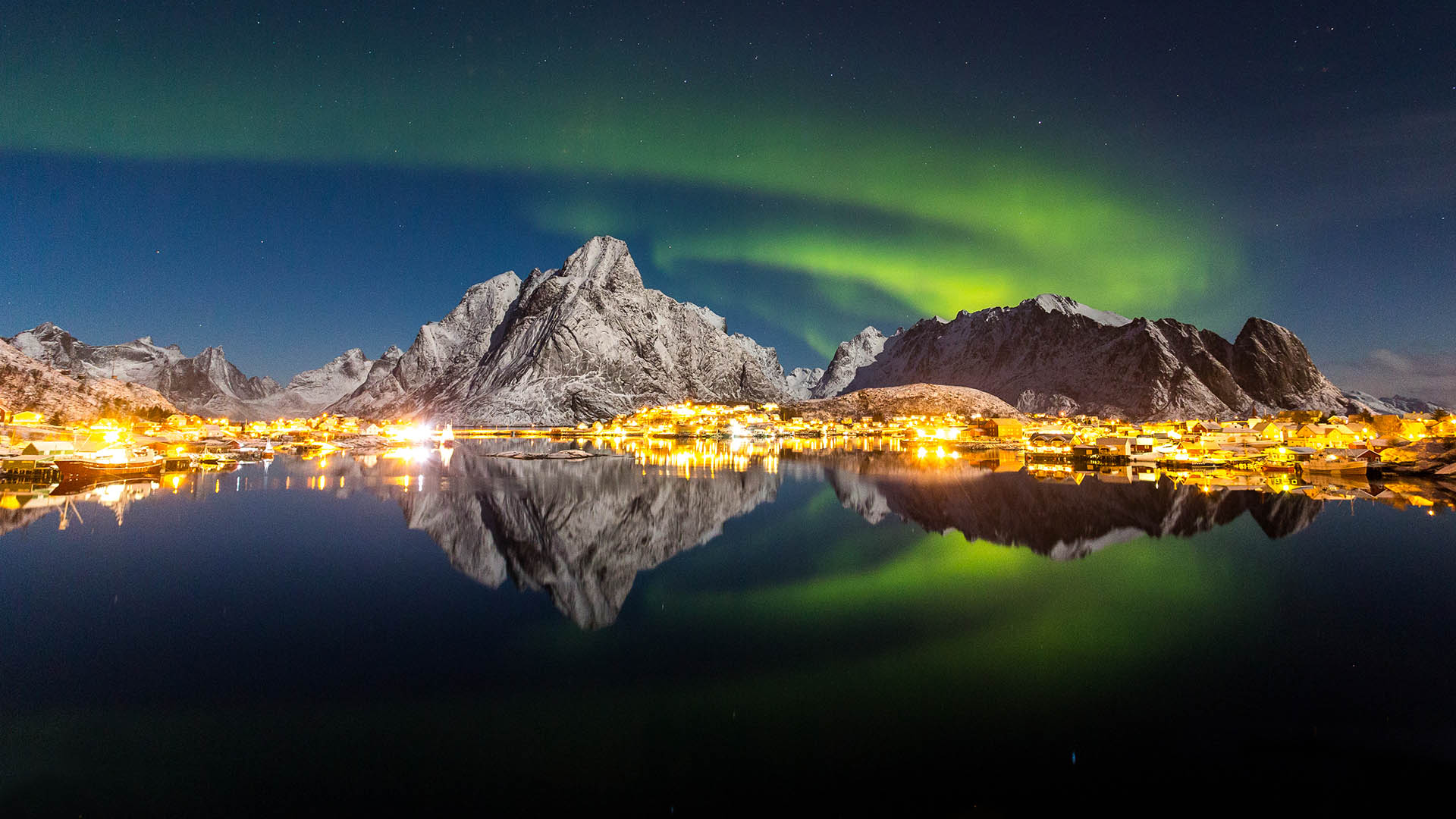
Norway in winter
Best for enjoying the northern lights & winter sports
Norway’s winter is magical! While these months may be cold and dark, the beauty of the landscapes more than makes up for it. The country is draped in thick snow, and the fjords are transformed into mystical ice realms.
If you’re looking for the best time to travel to Norway to witness a snowy wonderland, this is it.
Some roads are closed over the winter months, but you can enjoy cruises and train journeys all year long.
It’s a great time of year to travel through the snow-capped mountains and keep an eye on the dark skies. You may be lucky enough to spot some colourful dancing lights in the sky as well!
Temperatures fall to an average of -3 or -4°C (25°F) in both the capital and the north. By the coast, however, which enjoys a more temperature climate, it stays around 2°C (35°F).
Make sure to head north! Within the Arctic Circle, you’ll be able to enjoy the true meaning of winter.
One of the key draws of a winter trip to Norway is of course the northern lights. And the best location to have a chance to spot them is in Northern Norway.
In fact, there is a zone called the “Northern Lights Belt”, situated from 65 to 72 degrees north. It’s known for having the highestt auroral frequency and intensity. The closer you are to it, the better your odds are!
Both the city of Tromsø and the Lofoten islands fall directly within this area, so we highly recommend these destinations. You could also take on an Arcticcruise to the North Cape and Kirkenes. In fact, these are some of the best cruise journeys in Norway .
- Book a tour to Norway to spot the northern lights with these winter itineraries
- Related: 10 things to do when you visit Norway in winter
Winter may be the ‘off-season’ in some places, but in Norway you’ll find plenty to do! And we don’t mean just looking out the train window at the gorgeous mountains above, or searching for the northern lights.
In the winter months, you’ll be able to enjoy a host of unique activities, including reindeer- and dog-sledding. You could learn more about Sami culture, stay at the SnowHotel , or even chase the northern lights by snowmobile.
Stay the night inside a snow hotel with these ice hotel packages to Northern Norway
Near Oslo, you could visit the Holmenkollen Ski Museum and Tower . The museum is the oldest of its kind in the world and showcases more than 4,000 years of skiing history. Head up to the observation deck at the top of the jump tower for views of Oslo.
Another great place to experience the true north is in Svalbard – a Norwegian archipelago located closer to the North Pole. It is one of the world’s northernmost inhabited areas and is famous for its number of polar bears.
Mark your calendar for these winter events:
- Ice Music Festival, a glacial event happening every February in the alpine resort town of Geilo .
- Northern Lights Festival, a 10-day music festival held in Tromsø every January.
- Rørosmartnan held in February and considered the largest winter festival in the country.
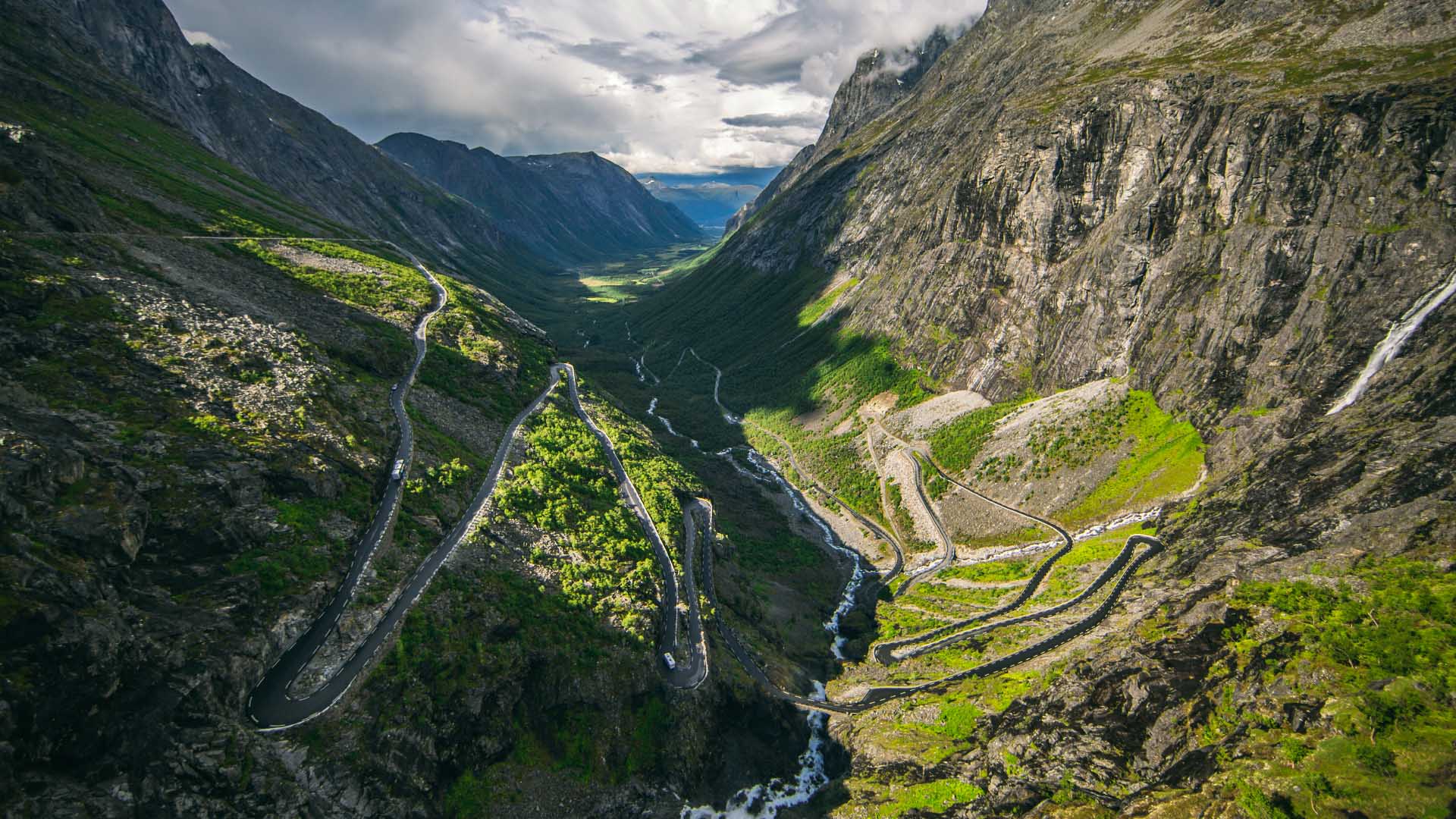
Norway in spring
Best for enjoying flora and bird watching
March , April and May are also beautiful months to visit Norway. As the winter snows melt, the rivers, lakes and waterfalls swell with fresh water and life. Snow-draped landscapes fade away and are replaced with swathes of lush green.
From April to May the weather rises between 0 and 11°C (32-52°F) in Oslo , and up to, on average, 4°C (39°F). As this is a changeable season, you never know as it may inch a bit higher or lower.
You’ll definitely enjoy the fjords in the spring! The western fjords are gorgeous all year long, but in the spring, the landscape transforms from wintry to luxuriant.
We recommend taking a coastal cruise from Trondheim down to Bergen, admiring the coast along the way. At this time of year, many summery activities reopen their doors so you can take advantage of these before the summer boom.
Boosted by the meltwaters, the waterfalls of Norway are at their most formidable during spring. You could go on a kayak or rib boat tour at Geirangerfjord to get close to the stunning Seven Sisters and Bridal Veil waterfalls.
One of Norway’s biggest attractions at this time of year is also the spring blossom. By May, the flowers are in full bloom across the country and, on a sunny day, the scenery can be out of this world.
In May, when the nicer weather has usually settled in, some roads reopen. One you won’t want to miss is the Trollstigen road near Ålesund. You could make sure to drive it on a road trip, or to book an optional excursion to go experience it.
Mark your calendar for these spring events:
- Stavanger Vinfest, a food and wine festival held in April.
- Constitution Day on 17 May, celebrated all over the country.
- Bergen International Festival beginning in late May.
Best time to visit for…
If you’re wondering when the best time of year to visit Norway is for a specific activity or to visit a certain location, read below. Nordic Visitor’s travel experts share their insider tips to help you plan your ideal trip.
Best time to visit Svalbard, Norway
A great place to experience the true north is in Svalbard – a Norwegian archipelago located halfway to the North Pole. It is famous for having more polar bears than human inhabitants.
If you’re keen to fly north, we recommend going between February and September. That is because of the number of daylight hours available during those months.
In the depth of winter, the region experiences a polar night and therefore the sun doesn’t rise at all. From February, you get a better balance of darkness, to spot the northern lights, and daylight, to go on excursions.
You’ll want to be able to admire the glittering icebergs, frozen tundra and maybe even spot the elusive white bear.
- Check out these fun tours of Svalbard
- Related: Read a first-hand account of a special visit to Svalbard
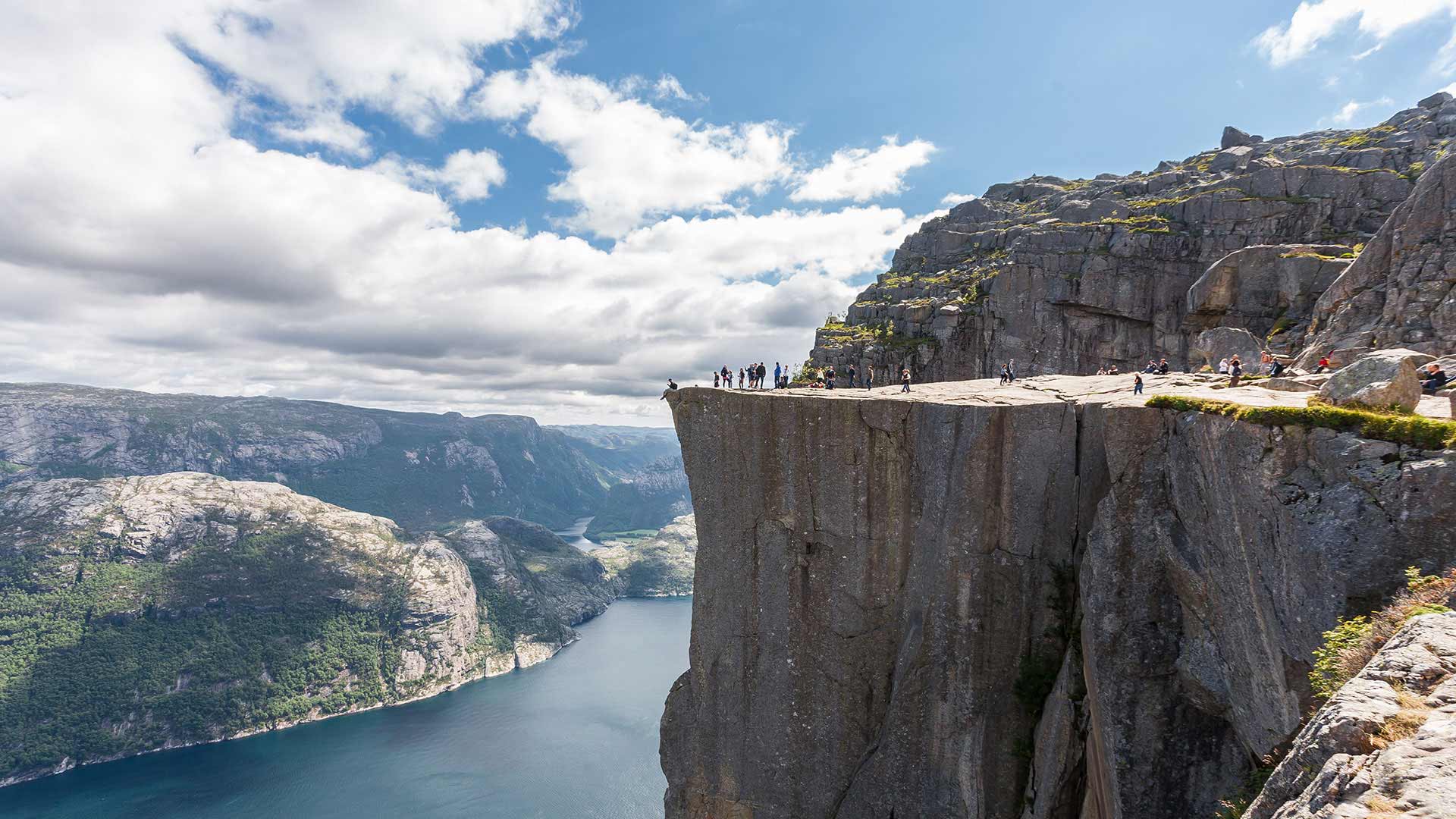
Best time to travel to the Norway fjords
The Norwegian fjords are amongst the most beautiful in the world. It is no wonder that the West Norwegian Fjords, Geirangerfjord and Nærøyfjord , are listed as one of Norway’s UNESCO World Heritage Sites . Picture tranquil waters, thundering waterfalls, and sheer mountain faces.
To see the fjords in all their glory, the summer is a great period for a visit. At this time, you could go kayaking along a fjord to take it all in from a different perspective. You could even try dipping your toes in or going wild swimming.
But there are benefits to the other seasons too. Come in spring to see the waterfalls running with even more power thanks to the snow and ice melting. In winter, you may get a view of snow-capped mountains and frosted waterfalls as you sail through the Norway fjords.
- Discover the majestic western fjords with one of these Norway tours
- Related: The best fjords in Norway
Best time to visit Norway for the weather
First, what is the best weather for you?
As mentioned previously, the warmest weather of the year is definitely during the summer. At this time, you’ll enjoy sunny days in the south, either for a city break in Oslo or to take on a fun excursion to the fjords.
But maybe you prefer colder days with crisp air and plenty of snow to enjoy fun activities. Then come in winter.
If you like mild weather, you’ll probably prefer the shoulder seasons. In April, May and September, you’ll enjoy weather that is perfect for hiking or exploring, with plenty of daylight to do so!
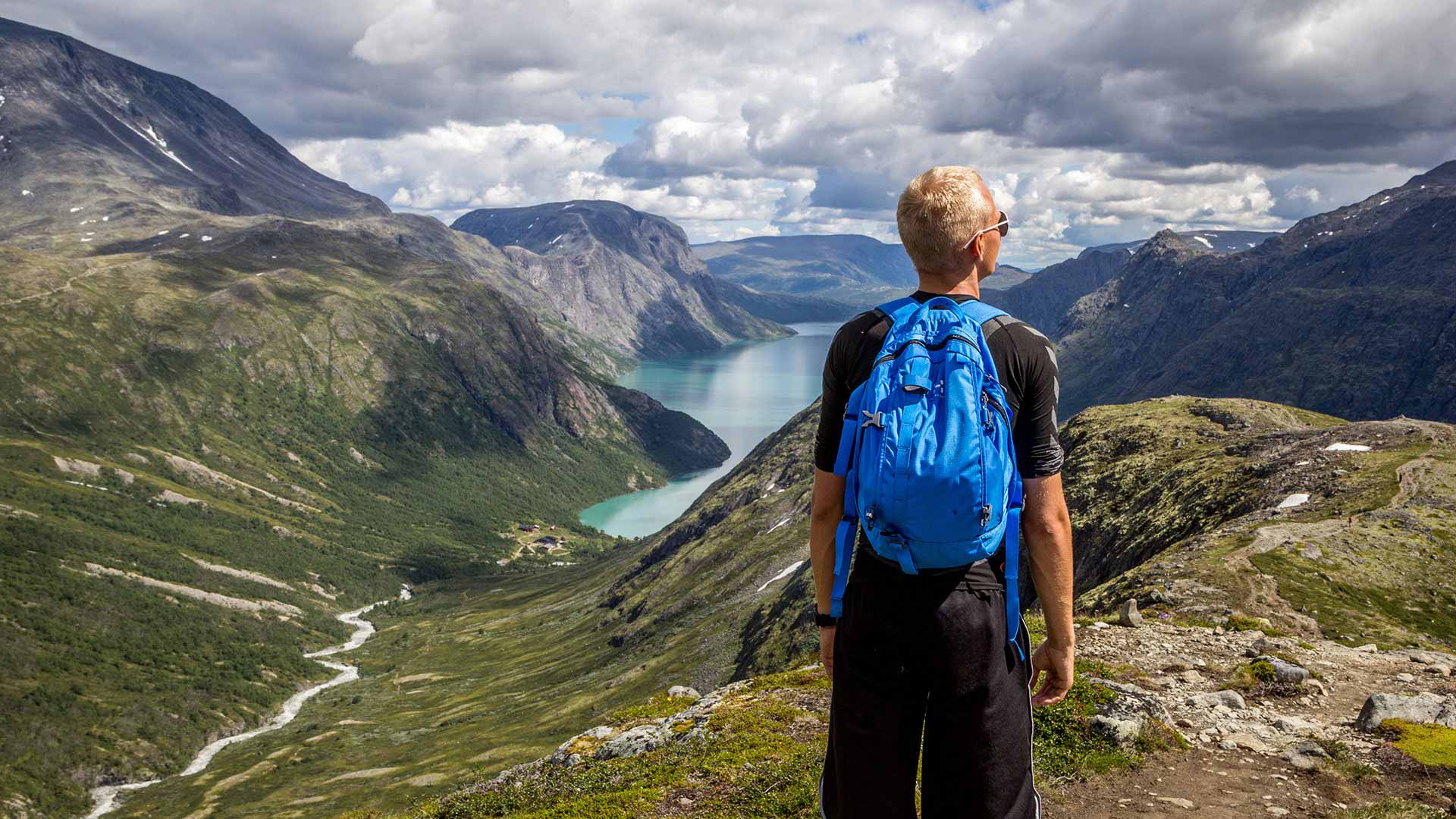
When is the best time to visit Oslo, Norway
Oslo, the formidable capital of Norway, is the ideal Nordic destination for a city break. It’s also a great gateway to discovering more of the country.
To see Oslo at your own pace we recommend visiting in the months just before or after the summer. This way you’ll enjoy all the top attractions with, hopefully, fewer crowds. This time of year is the best of both worlds.
Spend your days visiting the top landmarks, such as Akershus Fortress and the Royal Palace , which may have more availability at that time of year. Later, walk along Aker Brygge , the old waterfront, and enjoy al fresco dining in the bright and cool evening.
Visit Oslo in early winter for another fantastic experience. At this time, you could enjoy the charming Christmas markets and go sightseeing under fairy lights. A trip to Norway’s capital city is a great way to get into the festive spirit.
- Explore Oslo on a city break to Norway
Best time to visit Tromsø, Norway
Tromsø is a great year-round destination if you’re looking for stunning scenery and don’t mind a cooler day out.
Visit Tromsø between October and April to enjoy a winter wonderland and experience a polar night. This phenomenon, where the sun doesn’t rise at all, happens from late November until mid-January.
Another bonus of visiting in winter is the city’s location, straight into the “Northern Lights Belt”. This means you may be able to admire the lights from the city itself.
From Tromsø you could also journey across the northern coast of Norway, to the North Cape and all the way to Kirkenes. This is an amazing winter journey along the Arctic Circle.
In summer, visit Tromsø and the nearby Lofoten islands, to experience the polar opposite (pun intended!). From mid-May until late July, the sun doesn’t set at all. This is called the midnight sun. You could go hiking and enjoy the natural landscape at midnight if you wish.
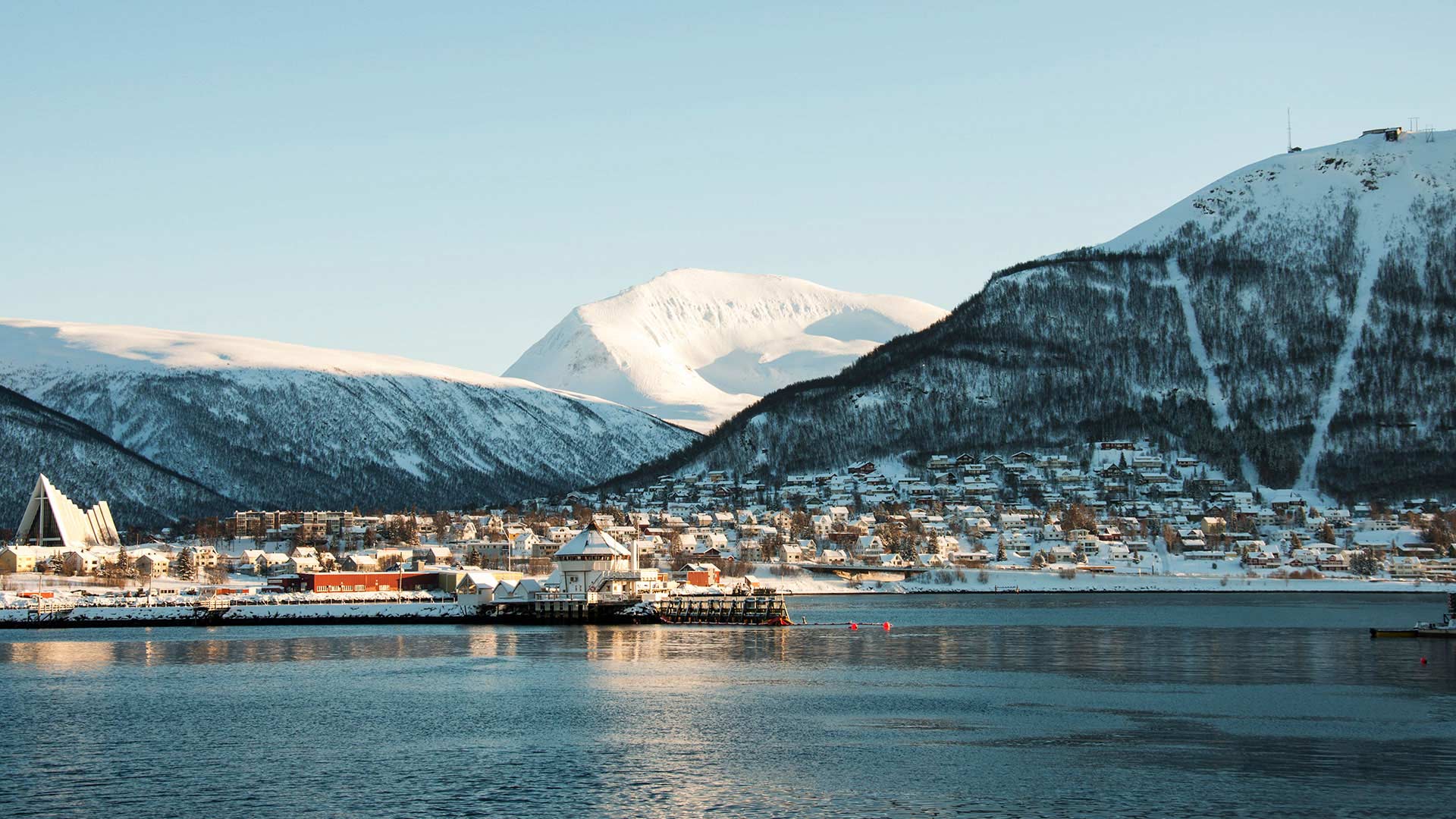
Best time to visit Ålesund, Norway
The charming port town of Ålesund is one of Norway’s most visited cities. This is in part thanks to its beautiful setting along a cluster of islands in the western fjords.
It has also become a popular stop as part of the Norwegian Coastal Voyage. If you’re cruising your way up or down the country, you could add a stopover in Ålesund. And it is definitely worth the visit!
We recommend travelling here in summer to experience it at its best and to enjoy all the activities available. These include angling, sailing, hiking, and kayaking, among others.
From Ålesund, you can cruiseto the nearby Geirangerfjord. You could also spend your days hiking to local viewpoints. Summer is the ideal time to walk up Mount Aksla and enjoy the panoramic views of the archipelago and the peaks of the Sunnmøre Alps.
- Take a look at these Norwegian culture trips
Best time to visit Norway, Sweden and Denmark
Are you looking for a grand tour of Scandinavia? This Northern European region, composed of Sweden and Denmark as well as Norway, is a fantastic destination come winter or summer.
The capital cities, Oslo, Stockholm and Copenhagen, are well connected. That means it’s easy to travel between each of them on one single trip.
In summer, you could drive or take a train and then a cruise to see what makes each city so special. In winter, you’ll be able to sightsee the highlights of all 3 countries with their mild weather and charming winter lights.
Travel just before or after the summer, to enjoy nice weather and plenty of daylight. At popular locations, such as the capitals, Norwegian fjords and top hiking spots, you’ll enjoy having more time and space to yourself.
- Combine a trip to Norway with Sweden and Denmark with these Scandinavian tours
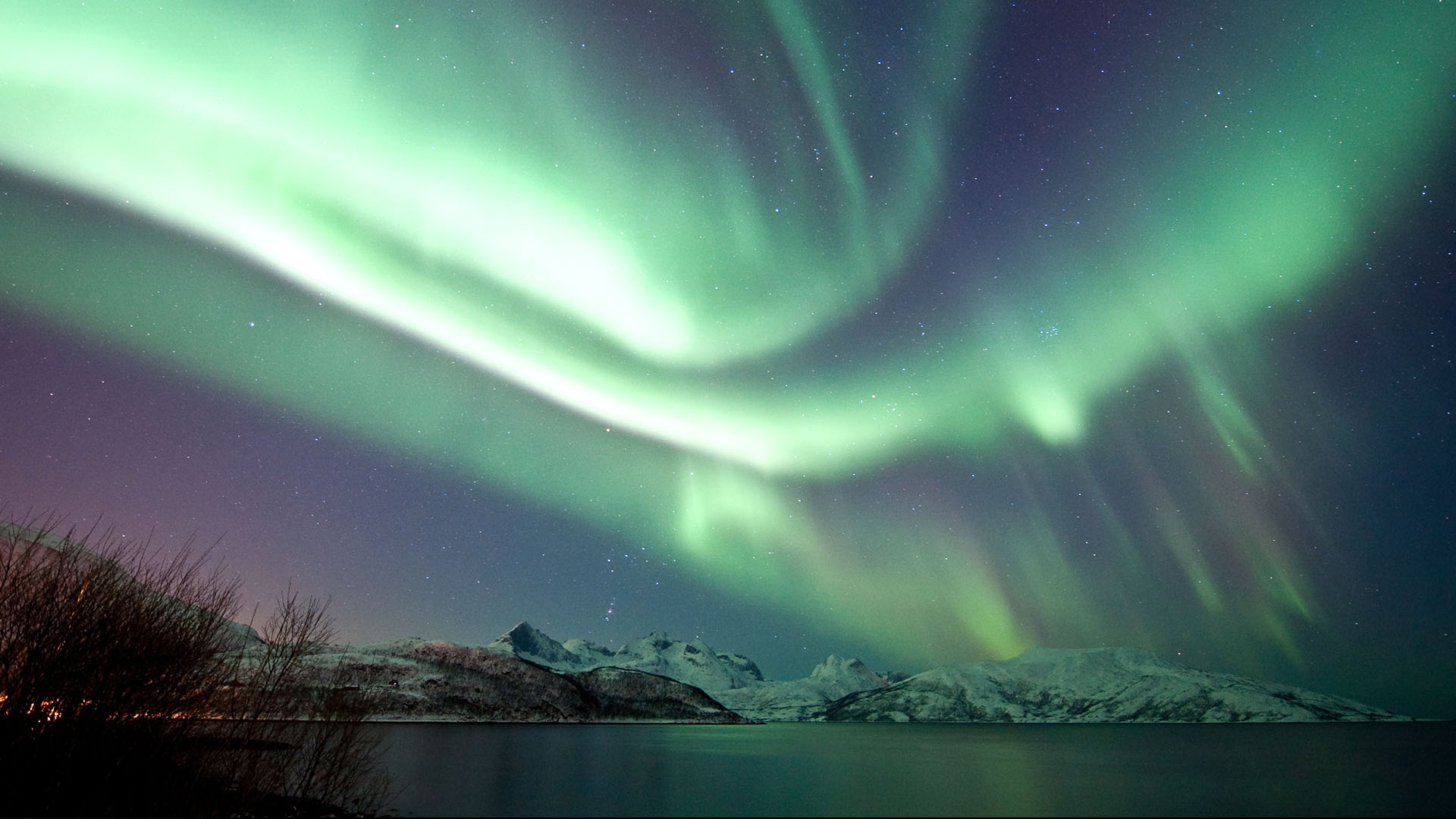
Best time to visit Norway for the northern lights
The northern lights, or aurora borealis, are at their best during the winter season. This means you should visit Norway between October and March.
From late September, the days become shorter making it easier to witness the auroras in the night sky. Indeed, you need darkness, good solar activity, and low light pollution to be able to admire them.
You’ll also want to journey into Northern Norway, all the way into the Arctic Circle, to spot the northern lights. The few prime locations for northern lights spotting in Norway are:
- Tromsø
- North Cape (Nordkapp)
- Book one of these aurora tours to see Norway under a sky lit with northern lights
- Related: Best places and times to see the northern lights in Norway
Best time to visit Norway and Iceland
To combine both these stunning countries into one epic Nordic trip, we recommend visiting in summer.
At this time of year you will benefit from longer days to make the most of your exploration. Take in the highlights of southern Norway like Oslo and the Norwegian fjords before flying to Iceland where you could tour the whole island.
You could even discover more of Scandinavia if you so wish and have the time for a longer trip. Start your tour in Stockholm, passing by Copenhagen before taking on Norway and Iceland.
Sights can be popular at the height of summer, so you could try planning your tour for early or late summer if you want a quieter holiday.
And if you would rather visit during the winter, fear not, it is also possible! In fact, this season has some bonus points of its own too. You’ll be able to admire the glittering frost over amazing Norwegian and Icelandic waterfalls .
This is also the time of year to travel to the Nordics if you want to catch sight of the northern lights. As the darkness sets in, from late September, it becomes easier to see them dancing in the night sky.
- Go on a combined tour of Norway and Iceland
- Or look up Iceland tours to explore the Land of Fire and Ice
Best time of year to visit Bergen, Norway
Bergen is another Norwegian city that can be visited all year long. As it is one of the rainiest cities in Europe, you’ll probably want to travel here in summer for the best weather.
In case of bad weather, fear not, there is plenty to do indoors. You could visit the 900-year-old Bergen Cathedral and one of Norway’s oldest fortresses, Bergenhus Fortress. There are also many museums like the Bryggens Museum, the KODE Art Museum , and the Hanseatic Museum.
But really Bergen is known as the gateway to the fjords and is an excellent outdoor destination. In summer, you could hike up one (or more!) of the seven mountains surrounding the city. You could also participate in fun activities like ziplining across Mount Ulriken.
You also won’t want to miss hiking or taking the Fløibanen funicular to the top of Mount Fløyen . You’ll get some amazing views of the city below and access to some top walking trails.
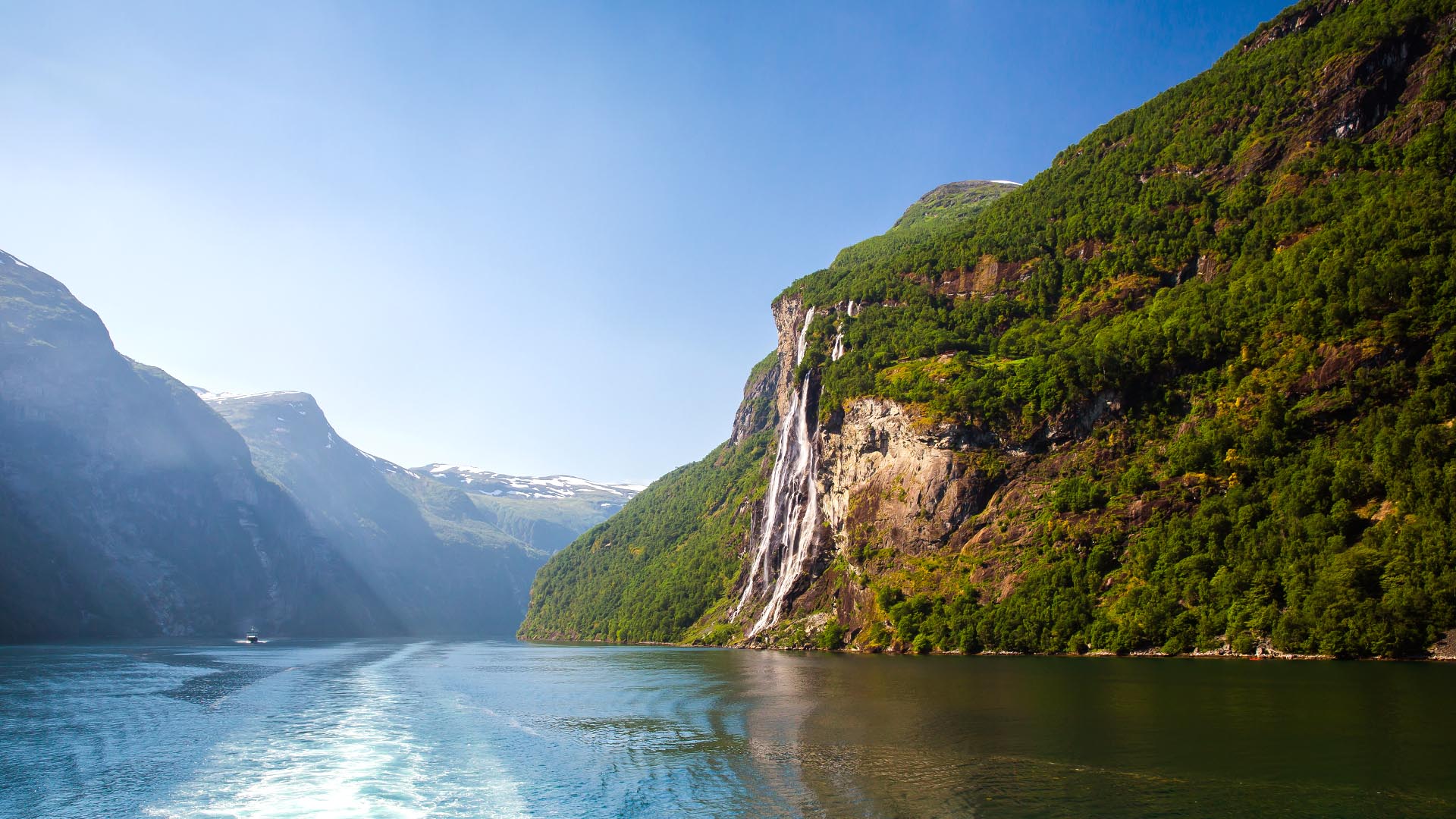
Best time to visit Norway on a cruise
You can cruise Norway’s magnificent and diverse coast any time of the year. That said, we do recommend the summertime for the best experience.
Between May and September, you’ll enjoy long days, ideal for sightseeing. That’s true from the boat or on excursion stops on the mainland. Take photos in the midnight sun and pack more in your day.
In winter, you may enjoy the smaller crowds, but days are much shorter. You may also find the sea is a bit rougher. The one bonus of a winter cruise is the chance to admire the northern lights in the sky above.
A cruise is, in fact, excellent for spotting the auroras as you’ll be away from city light pollution.
- Browse fjords cruise & train tours
- Discover Norway on a Hurtigruten voyage
Best time to go to Norway for hiking
Do you have dreams of standing proudly atop Trolltunga or Pulpit Rock ?
You may have seen the scenic photos of people standing by the cliff edge, with calm fjords below and rocky mountains in the distance.
April until October is the best time to hike to those famous heights. To skip the potential queues for the best Instagram snaps, you should visit during the shoulder season. Late spring and early autumn are quieter times of year that are fantastic to experience the mountains in a bit more peace.
In fact, autumn may be the best time as you’ll find more paths accessible at this time compared to spring. And you’ll be treated to the orange and yellow foliage of the forest.
- Check out these active tours of Norway
Best time to visit Norway for the midnight sun
The midnight sun is an incredible phenomenon whereas the sun does not set below the horizon. It occurs inside the Arctic Circle during summer.
For example, Tromsø and Svolvær , located inside the Arctic Circle, experience the midnight sun between mid-May and late July. You’ll want to visit the northern parts of Norway (or neighbouring Sweden and Finland) at this time to witness it.
Imagine hiking or sitting by the Norwegian Sea admiring the scenery while basking in the light of the sun in the middle of the night.
Just make sure to bring an eye mask to help you sleep!
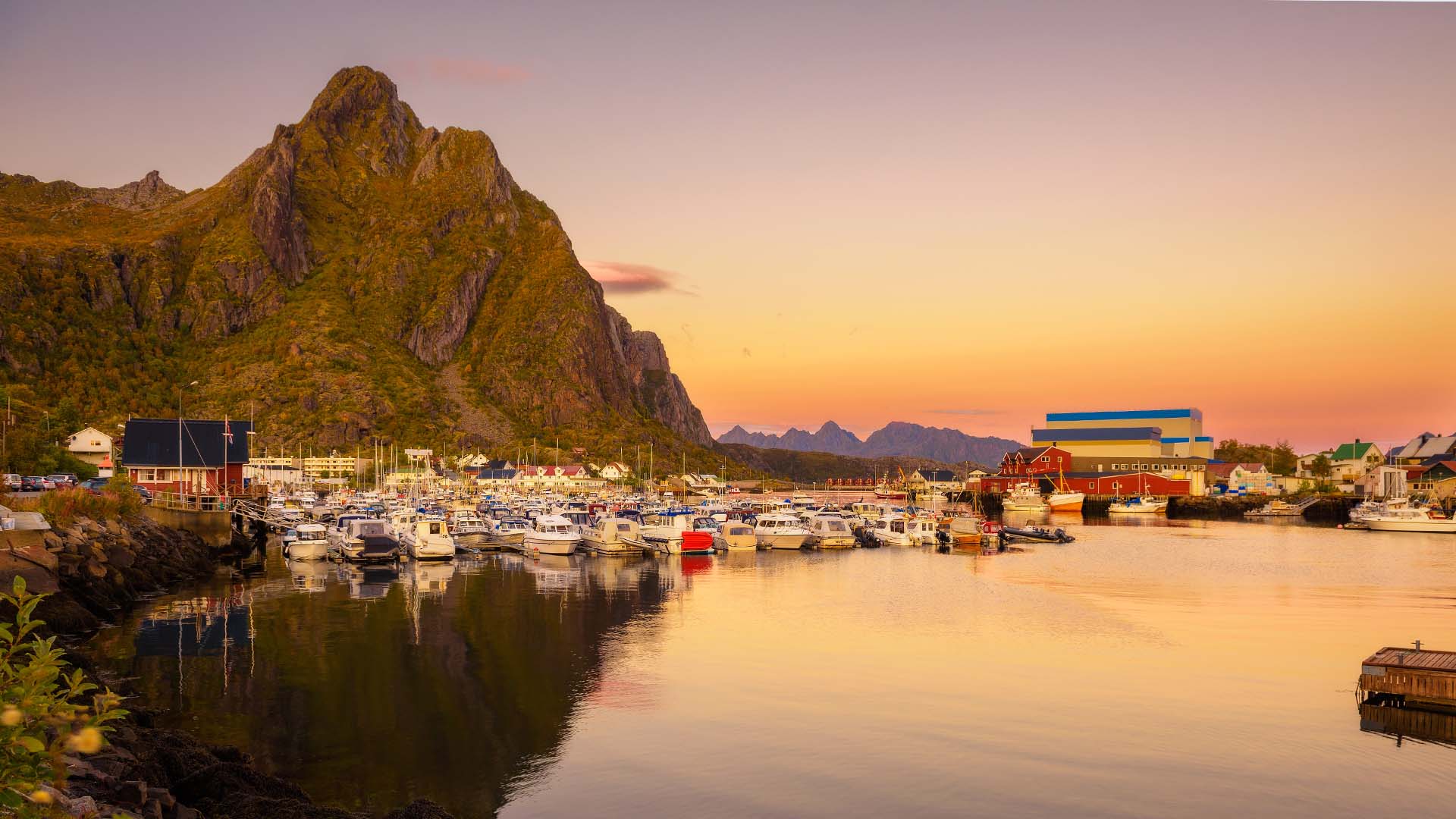
Best time to visit Norway for whale watching
Every year, whales pop up along the Norwegian coast. For this reason, it’s a good location to go on a wildlife cruise to spot them up close.
These gentle giants of the sea are most commonly seen along the Vesterålen coast, just north of Lofoten. Make sure to go there in summertime for your best chances and for more varied sightings.
You could spot sperm whales, but also pilot whales, minke whales, humpback whales, dolphins, and killer whales.
For the best whale-watching experience in Northern Europe, we recommend heading to North Iceland instead. Indeed, Húsavík is considered the capital of whale watching. Trips are available all year long, but summer is the best time to visit.
You might see dolphins, minke whales, humpback whales as well as some sperm whales and maybe the elusive blue whale.
Learn more about whale watching in Iceland .
What to pack for a trip to Norway
The weather in this part of the world can be fickle, but don’t let that stop you from enjoying the best of Norway. Pack well to come ready for rain or sunshine and take advantage of your trip to the fullest.
For all seasons, you should pack layers so you can be flexible depending on the day's temperature. We especially suggest bringing a waterproof jacket and comfortable walking or hiking shoes.
Even in the summer it’s best to have a pair of light gloves, a hat and a scarf handy. Don’t forget your sleeping mask to help with the light nights of summer.
In winter, make sure to pack some warm layers (preferably woollen) along with an insulated jacket.
Finally, don’t forget your camera to snap away at all the spectacular landscapes!
- For more travel inspiration, check out these classic holidays in Norway
Norway is an exceptional destination that can be enjoyed all year long. We hope this post convinced you of that!
When you’re ready to book your dream Norway holiday, take a look at these top Norway packages . And if you’re still not sure or would like local advice, get in touch . Our travel experts can be reached s via live chat, toll-free numbers or email.

Camila grew up between the French Canadian and Chilean cultures, before moving to Scotland in 2012. When she’s not travelling or writing about travels, Camila loves to read, run, and puzzle. Her favourite destinations have been Reykjavík, Copenhagen, Estonia and Cape Town.
Find Camila on LinkedIn .
Getting there
We'd love to give you the same amazing travel experiences as you read about in our blog! To visit the destinations and attractions mentioned in this post - and to discover a few new highlights along the way - check out these recommended Nordic Visitor tours.
HIGHLIGHTS OF NORWAY
- USD ($)
- CAD ($)
- AUD ($)
COMPLETE NORWAY
Related posts, 5 top norway road trips: a local expert’s view.
Blogs , Activity , Scandinavia , Norway , Guides , Things to Do
7 Incredible Things to See and Do in Norway
Best time & place to see northern lights in norway, 10 things to do in norway in winter.
The Best Time of the Year to Visit Norway
When to go to Norway is a common question among first-time Norway travelers. The best time to go to Norway suitable for most travelers is early summer, especially the months of June and July. The weather is pleasant and the days are long however it is also peak season. The other seasons offer plenty to do, though it can be cold and days are very short.
Compared to some of its Northern neighbors, Norway's weather is quite mild. That's because of the Gulf Stream which gives it a temperate climate, however temperatures can vary wildly depending on where in Norway you are. More northern areas can have temperatures reaching into the 80s Fahrenheit (27 degrees C) during the summer and some of the snowiest winters. Generally speaking, Norway experiences four seasons with cold winters and mild summers. For more detailed informations, read our guide to the weather and climate to Norway .
Tourist Attraction Availability in Winter
Many major outdoor attractions, including some mountain hiking paths, are closed in the winter. The large amounts of snow coupled with cold conditions make it dangerous for people to visit. If there are trails or outdoor sights you especially want to see, look up the closure schedule before booking your flight. Whatever you do, do not ignore closures and posted warnings. They're there for your safety.
Peak Season in Norway
The summer is Norway's peak season. The weather is nice and the longs months of darkness are broken with almost constant daylight. Because of that expect lines at popular attractions to be longer. Accomodation and flights will also likely cost more. To get the best of both worlds, plan your trip for late Spring or early fall. May and September are wonderful alternatives for when to go to Norway and get lower rates, and the weather in Norway will still be mild enough for outdoor activities and sightseeing.
Even though it's spring the weather will still feel like winter. Don't expect temperatures much higher than 40 degrees F (4 degrees C) though days are starting to get longer. Ski season also stretches well into spring with resorts open as late as April. In May it's warm enough to enjoy the outdoors and summer tourists haven't started arriving yet.
Events to check out:
- The biggest literary festival in the Nordic region happens every May in Lillehammer. Celebrating its 25th year in 2020 the festival has readings, concerts, exhibitions, and more.
That's the time of the Midnight Sun , so you'll get very long days in southern Norway or even sunshine around the clock in northern Norway. And with the warm weather, there are many things to do and places to go in Norway. You can hike the mountains, explore the fjords, or get to know the country's cities. The months of June and July are also the time for Norway's highest tourism levels, so while all sights and attractions will be open, you will see some tourist crowds.
- See short films from Norwegian and international filmmakers at the Grimstad Norwegian Short Film Festival in June.
- Adventurous travelers flock to Voss in late June for a week of extreme sports at Ekstrem Sport Veko .
Fall is the ideal time to visit for travelers looking to save money. The weather is starting to cool off but hasn't reached the winter lows yet. Fall is also a shoulder season as summer is over, but the ski season hasn't started yet. As such lodging and flights are cheaper in fall than in other seasons however popular outdoor attractions have begun to close. If you're traveling to Norway to see some natural beauty, time your visit for September when the weather is still mild enough for sightseeing. Northern lights season begins in October.
- Jazz lovers should head to Lillehammer for the DølaJazz Festival in October for performances from local and foreign musicians.
Days are very short in the winter, lasting only 5 or 6 hours. However the upside to the short days are the ample opportunities to see the Northern Lights. Winter can also be bitterly cold. Much of the country will be covered in snow so if you don't like the cold stuff, visit during a different time. Avid skiers and snowboarders can start hitting the slopes as early as November. Besides hunting for the Northern Lights, expect to spend time doing indoor activities like exploring a museum or two or catching a live show.
- The Tromsø International Film Festival is the country's largest and it takes place each January. In 2019 more than 60,000 films were submitted. Also because of the short days, films can be screen outdoors.
- Stay in Tromsø to enjoy music of all genres, stage performances, lecutures, exhibitions and more at the Northern Lights Festival from the end of January to February.
- Bundle up and head to the Ice Music Festival in Finse on Feb. 7 and 8. Celebrating 20 years in 2020 this festival features music played entirely on instruments made from ice.
The Best Time to Visit Spain
The Best Time to Visit Cape Town
The Best Time to Visit France
The Best Time to Visit the French Riviera
The Best Time to Visit Marseille
The Best Time to Visit Japan
The Best Time to Visit Boston
Weather in Iceland: Climate, Seasons, and Average Monthly Temperature
The Best Time to Visit Morocco
The Best Time to Visit Naples, Italy
The Best Time to Cruise Alaska
The Best Time to Visit Sweden
Weather in Norway: Climate, Seasons, and Average Monthly Temperature
The Best Time to Visit Iceland
January in Iceland: Weather, What to Pack, and What to See
The Best Time to Visit Finland

When to Visit Iceland: A Guide to Finding the Best Time of Year

Are you planning to visit Iceland? Then, it is essential to choose the best time of the year to experience its breathtaking natural beauty, take a glimpse of the stunning Northern Lights, and indulge in exhilarating activities. Iceland is a country of stark contrasts, with long winters and short summers. The unique weather conditions demand a careful selection of the right time to travel. So, when is the best time of the year to visit Iceland? Let’s discover the answer.
- 1 Winter: November to March
- 2 Spring: April to May
- 3 Summer: June- August
- 4.1 Conclusion:
Winter: November to March
If you’re looking to experience the full force of Iceland’s dramatic winter landscapes, then this is the perfect time to visit. Starting in November, the winter holiday season begins in Iceland, making it a popular tourist destination. During this time, the island is covered in snow, and the stunning ice caves and glaciers are at their most beautiful.
The cold weather provides a unique opportunity to experience some once-in-a-lifetime activities such as ice caving, Glacier Hiking, Snowmobiling, and Northern Lights Hunting, to name a few. These activities are best enjoyed in the winter months, where the days are shorter.
Spring: April to May
April and May are the months that mark the transition from winter to spring in Iceland. The snow melts, the flowers bloom, and the temperature starts to rise. This is the perfect time to visit if you want to avoid massive crowds and enjoy more mild weather. During this time, you can enjoy some of the best hiking trails in Iceland without too many tourists around.
The springtime in Iceland is also the perfect time to witness the puffins. Puffins are migratory birds that come to Iceland only during this time. Visitors can take a boat tour to the bird islands to see the puffins and other seabirds in their natural habitat.
Summer: June- August
Summer in Iceland is the most popular time of year to visit the country. The weather is mild, and you get to enjoy the “Midnight Sun” phenomenon where the sun doesn’t set, resulting in 24 hours of daylight. The warm weather allows visitors to explore more stunning landscapes and indulge in outdoor activities.
If you’re planning to visit Iceland in the summer, don’t forget to witness the famous Icelandic horse round-ups, the Reykjavik Arts Festival, and experience the party culture, as Icelanders truly know how to throw a good party.
Fall: September to October
The fall season is the perfect time to visit Iceland if you want to experience some great weather, the Northern Lights and avoid the crowd. The temperate remains pleasant with a golden hue throughout the autumn.
September and October are perfect times for travelers looking to get a good deal on accommodations since tourist season has ended, and hotels and guesthouses offer lower rates. Hiking trails remain open until October, and you can still indulge in various activities such as whale watching, visiting the natural hot springs, and more.
Conclusion:
There you have it, folks! The best time to visit Iceland depends on what you want to experience. Whether you are looking to indulge in winter activities, witness the Northern lights, explore beautiful natural landscapes and go on outdoor adventures, or experience Iceland’s unique party culture, each season has something special to offer. So, choose your time wisely and have the trip of a lifetime!
Similar Posts

Ultimate Guide: Iceland Ring Road in 5 Days – Tips & Tricks
Hello and welcome to our travel guide blog! Are you planning a trip to Iceland but only have 5…

Unlocking the Mystery: Is Iceland Included in EU Data Roaming?
Is Iceland part of EU data roaming? Do you plan on visiting Iceland soon? Perhaps you’re already here and…

Your Ultimate Guide to Using Your EU Driving License in Iceland
As you plan your trip to Iceland, one question may be on your mind: Is EU driving license valid…

Discover the Cheapest Month to Visit Iceland: A Comprehensive Guide
Have you ever dreamt about visiting Iceland but always postponed your trip because of the budget constraints? This article…

Exploring Iceland: A guide for English speakers
Can I go to Iceland if I speak English? Have you been wondering whether you can visit Iceland despite…

Traveling to Iceland with Covid: Can You Fly? – Expert Guide
Are you planning a trip to Iceland but are overwhelmed by the question of whether you can fly if…
Leave a Reply Cancel reply
Your email address will not be published. Required fields are marked *
Aurora Tracks See Northern Lights

ICELAND Northern Lights Month-by-Month Planner

Planning a successful trip to Iceland for the aurora begins with choosing the right time of year. In this article, we breakdown Iceland Northern Lights month-by-month, and explain what the best month to see northern lights Iceland is.
Iceland is well-renowned as a prime aurora-chasing destination, with many tours and accommodation designed around aurora hunters seeking a glimpse of these spectacular lights. However, despite the inspiring photos and travel marketing hype, it is not as simple as wandering over to the icy land, stepping outside your hotel, and seeing them blaring in the sky whenever you like. There are many factors that come into play which allow you to see the northern lights, and the most important one is choosing the right time of year.
If you plan on visiting Iceland to view the northern lights, it is important to make sure that you plan ahead of time. Every year, countless people make their way up to Iceland in order to hunt for the elusive auroras, which can make it very difficult to find available accommodations if you are searching at the last minute. In this guide, we explain the best month to see Northern Lights Iceland, to ensure you plan and book your trip for the right time and give you the best chance of seeing them. We also explain other factors that affect aurora visibility, so you can plan your trip accordingly.
So, read through this guide as well as our other Iceland Northern Lights articles here , and start planning for a wonderful aurora vacation.
Factors Affecting Iceland Northern Lights Visibility
There are many factors that affect the visibility of the aurora borealis in Iceland. These include the location, the Earth’s magnetic activity, solar activity, weather conditions, light pollution, both the season and time of day, as well as the solar cycle.
Geographical Location
The closer to the poles you are, the easier it is to view the elusive lights. In the northern hemisphere, the best locations to see the aurora borealis are Alaska, Scandinavia, northern Canada, and of course Iceland. The chances of catching a glimpse of the northern lights increase as you get closer to the magnetic poles.
Magnetic Activity
The magnetic activity also plays a very important role in the visibility of the auroras. The lights themselves are actually caused by an interaction of the sun’s solar radiation with the Earth’s magnetic field. When magnetic activity surrounding the planet increases, it helps to enhance the visibility as well as the intensity of the northern lights. The best time for viewing the auroras is when geomagnetic storms are at their highest.
Solar Activity
Naturally, solar activity is crucial to the creation of auroras. The more active the sun is, the greater the visibility of the northern lights. During solar cycle peaks, large amounts of radiation are ejected from the surface of the sun into space. As this solar radiation passes around the Earth’s magnetic field, it results in an ionization of the upper atmosphere. This ionization is what creates the northern lights.
Weather Conditions
While the actual weather conditions play very little role in the creation of the auroras, they are crucial to ensuring that the elusive lights are visible. It takes very little cloud cover or precipitation to completely obstruct the view of the northern lights. This is why most aurora hunters prefer seeking out the elusive lights during the winter months. The skies are darker and clearer during the winter months than at any other time of year.
Light Pollution
The closer you are to a major city, the greater the chances that light pollution can interfere with your ability to see the northern lights. If you have ever taken a trip to another part of the country, then chances are you could easily spot where a major city is on the horizon, by the halo of light that envelops it at nighttime. This is light pollution, and it can greatly diminish your ability to view the elusive lights.
Season and Time of Day
The auroras are technically visible year-round. Astronauts in outer space can view the elusive lights regardless of the time of day or season. But on earth, it is best to hunt for the northern lights during the time of year when the night is the longest. The longer the night, the darker the skies, and the easier it will be to view the auroras.
Solar Cycle
The level of solar activity peaks every 11 years. This is known as the solar cycle. And while it is possible to view the northern lights during the winter when the solar cycle is at its weakest, the odds of capturing a glimpse of the elusive lights increases during the peak of the solar cycle. During the last major solar cycle, the solar activity was so great, that the auroras could be seen as far south as France and Kentucky. For further explanation of the best years to see the aurora and the solar cycles read our article here .
BEST MONTH TO SEE NORTHERN LIGHTS Iceland
When it comes to viewing the aurora borealis in Iceland, the best time of year is between September and April. While there is no guarantee that you will actually view the auroras when visiting Iceland during these months, the odds of catching a glimpse of them increases substantially.
The best months to view Northern Lights in Iceland is September to April.
Of that period, many seasoned aurora hunters choose to do their northern lights hunting in September and October , or February and March . These months are close to the equinoxes which some people have said anecdotally is best for aurora activity. More importantly, these months side-step the snow storms of Winter, which bring in cloud cover that can obstruct views of the aurora. Not to mention, it is more pleasant being outside when it’s not so cold that your hair freezes and breaks off.
Iceland Northern Lights Month-by-Month Planner
It is possible to capture a glimpse of the elusive lights in Iceland over the course of an 8-month period. Starting in September, the days begin to shorten and the nights become longer. This continues on until the peak of winter when the night lasts for nearly 24 hours each day. As the seasons segue from winter into spring, the chances of capturing a glimpse of the auroras decreases with each passing day.

Considerations for Iceland Northern Lights in September:
September is one of the first months of the year that the northern lights can be routinely viewed in Iceland. It is best to visit the country towards the end of September when the weather is still hospitable, but the longer nights provide ample opportunity to hunt for the lights. For sightseeing, the countryside is beautiful as the trees express their red and orange autumn colors, and the days are still mild enough to walk around outside comfortably.
Iceland in October Northern Lights Considerations:
By October, as the nights continue to get longer, the weather conditions change and tend to become a little more difficult to predict. While the temperature is still bearable during the daytime, the night brings the first major snowstorms of the year. As a result, it’s important to pay close attention to local forecasts before making your way out into the Icelandic countryside to hunt for the lights.
Considerations for iceland northern lights november:
The nights continue to get longer throughout November, and the air gets increasingly colder. During this time of year, the snowstorms tend to even out, making it easier to predict the best time to head out into the countryside to view the auroras. Make sure to avoid a full moon, as the moon can create excessive amounts of light pollution.
Considerations for iceland Northern Lights in December:
December provides some of the longest nights of the year. It is also one of the coldest times of year to visit Iceland. While it may be one of the best times of year to visit the country and view the auroras, keep in mind that it is also the most popular time of year for tourism. During December, most of the lodgings will be fully booked.
Considerations for January Northern Lights in Iceland:
During the month of January, the skies are clearer than any other time of year. The nights are at their longest, and the temperatures at their coldest, but the odds of catching a glimpse of the elusive auroras increases substantially. Due to the frigid conditions, the chances of finding vacancies increases as well.
Considerations for February Northern Lights in Iceland:
As the year segues from January into February, the nights begin to shorten and the days grow longer. Nevertheless, the nights are still long enough to ensure plenty of opportunities to view the elusive lights. The skies are generally clear throughout the month, which enhances the visibility of the lights as a dance through the heavens.
Considerations for Iceland northern lights in march
By March, the first thaws of the year begin to warm the Icelandic countryside making it more bearable for aurora hunters. While the nights are still long enough to view the lights, the odds of capturing sight of them decreases with each day. Early March is one of the most popular times of year for seeking the northern lights throughout Europe. However, the snow melt will make the ground wet and boggy for outside hiking, so be prepared and take a good pair of boots.
iceland northern lights in april Considerations:
During the earliest parts of April, it is still possible to view the northern lights in Iceland. However, as the month progresses, it will be increasingly difficult to view them. By mid-April, the chances of capturing a glimpse of the elusive lights fade into oblivion.
May, June, July, August – AVOID THESE MONTHS
Iceland northern lights in may-august considerations:.
While this time of year is popular for vacationers as it coincides with summer break, when it comes to aurora-hunting it is very important that you avoid these months. The days are simply too long and bright, and the short nights do not have the deep darkness that is needed to reveal the northern lights.

Common Question: Can you see the northern lights in Iceland in July?
No, for one main reason, there is too much sunlight. In the northern regions of the world close to the Arctic Circle, the daylight hours are extremely long, reaching almost 24 hours in some parts. For successful northern lights watching, you need total darkness, to allow the aurora to shine against the dark sky. While the aurora borealis is always there, you can only see it when it is dark. Think of northern lights viewing like star-gazing – the stars are always there, but you can’t see them during the daytime because it is too light. The same principle applies to the aurora borealis. It is simply not dark enough to see northern lights in Iceland in July. You will not be able to see northern lights in Iceland in during the entire period of May, June, July for this reason.
Day Activities to Enjoy While Waiting for the Northern Lights in Iceland
While there are some who visit Iceland purely to view the northern lights, many other visitors to the country want to experience all that the country has to offer. This is why most lodgings offer a wake-up service when the lights appear, and provide an endless list of activities to keep you busy throughout the day. Here are some of the best daytime activities to keep you busy while waiting for the northern lights to appear.
Whale Watching
Of course, nothing beats getting up close and personal with whales. May to September are the best months for catching whales crossing through the Icelandic waters, so if you’re visiting Iceland northern lights in September make sure to include whale watching in your itinerary, too. There are countless whale-watching opportunities throughout Iceland. Some of the best destinations to find a whale-watching expedition are Reykjavik, Akureyri, and Husovik. You will have the opportunity to view orcas, humpbacks, as well as minke whales.
Golden Circle Tour
One of the most popular attractions in Iceland is the Golden Circle. This is a route that takes visitors to 3 of the most popular destinations in the country. Visitors who take a tour of the Golden Circle will be able to visit the Geysir geothermal area, Thingvellir National Park, as well as the Gullfoss Waterfall.
Glacier Hiking
For those feeling a little more adventurous, there are plenty of guided tours that will take you hiking out on a glacier. They provide you with all of the proper equipment that you need and an experienced guide will take you out to explore the awe-inspiring landscapes that stretch on for miles.
Ice Cave Explorations
Naturally, if there are glaciers in Iceland, then there are also ice caves to explore. Take advantage of a magical expedition through the many beautiful, blue, ice caves in the country. Experienced guides will take you on an amazing expedition through the frigid blue caves.
Snowmobiling
For those looking for a little bit of an adrenaline rush, snowmobiling is always an excellent way to see the Icelandic countryside. Strap on a cold winter suit, and head out onto a glacier on the back of a high-powered snowmobile as it cuts through the Icelandic countryside at break-neck speeds.
Hot Springs and Geothermal Spas
Not only is Iceland known for its stunning snow-covered vistas, but it is also well known for its geothermal activity. Due to the high level of geothermal activity in Iceland, hot springs are found at many different sites. The most popular hot springs in the country can be found at the Blue Lagoon.
Snowshoeing
During the peak of the winter months, when the Icelandic countryside is covered with fresh layers of powdery snow, the best way to view the magnificent vistas is by snowshoeing through the countryside. There are countless trails and experienced guides will take you on an amazing adventure through the wintry scenery. Since snow is of course essential for this activity, the best months for it are the most snow-covered ones, from December to February/March.
Dog Sledding
But, if you’d really like to view Iceland the way it was meant to be seen, then you have to take a dog sled. There is nothing more thrilling than being pulled across the snow-covered landscape by a team of friendly yet energetic huskies. The time of year to enjoy dog sledding is of course in winter, from November to March, since snow is essential for this activity. But beware, from personal experience, being pulled in a sled at high speed in January is terrifyingly cold, to the point of fearing I had frostbite on my toes – despite that, it was truly a memorable experience.
Final Tips for Iceland Northern Lights Month & Time
By now, you should have a pretty good idea of Iceland northern lights month and time of year options for your aurora vacation. To summarize quickly, the best month to see northern lights Iceland is September to April. To fine-tune that time period, you may like to consider September-October or February-March for your trip. While December and January are very dark and renowned for northern lights, those months are often plagued by snow clouds and it is bitterly cold to spend time outside waiting for the aurora to appear.
Since you’re planning in advance, I also suggest you read about the best years to see the aurora based on solar activity , since we are coming up to a solar peak. Choosing a year with high solar activity will maximize your chances for seeing the northern lights, and it pays to spend a few minutes learning about this aspect of it.
For more resources, be sure to check out our Northern Lights Iceland category page on this website, which is packed full of articles about seeing the aurora in Iceland, to help you plan your vacation.
Happy aurora chasing!
Further Reading and Sources:
- Visit Iceland https://www.visiticeland.com/article/northern-lights-in-iceland
- Thingvellir National Park https://www.thingvellir.is/en/
Related posts:
- ICELAND Where to See Northern Lights | Best Places
- NEWS: ICELAND 2023 Volcano Halts Aurora Borealis Hunters
- What is the Best Time to See Northern Lights NORWAY?
- Best Northern Lights Hotels ICELAND for All Budgets
Related Posts
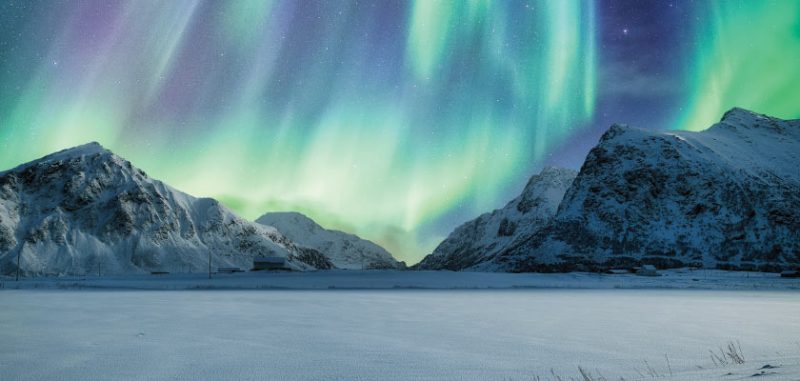
Best Time of the Year to See Northern Lights (Monthly Planner)
Trying to work out the best time of the year to see Northern Lights? In this month-by-month guide to the Aurora we share the best…

Best Place and Time to See Northern Lights 2020-2035
Want to know exactly where and when to see Northern Lights? Discover the best place and time to see Northern Lights across the globe, inc…

5 Great Short Tours to Northern Lights ICELAND
Looking for the best short tour to see Northern Lights in Iceland? In this article, we share some of the most popular short tours to…

5 Most Popular ICELAND Northern Lights Vacation Packages (2022-2023)
Considering a trip to Iceland to see the Aurora? Here we share 5 of the most popular Iceland Northern Lights vacation packages taking bookings for…
- Search Please fill out this field.
- Manage Your Subscription
- Give a Gift Subscription
- Newsletters
- Sweepstakes
- Destinations
The Best Times to Visit Paris for Great Weather, Events, and Fewer Crowds
Not that you can ever go wrong with a trip to the City of Light.
:max_bytes(150000):strip_icc():format(webp)/maya-kachroo-levine-author-pic-1-2000-1209fcfd315444719a7906644a920183.jpg)
Paris is one of the world’s most beautiful cities, stuffed with iconic landmarks, renowned museums, designer boutiques, and acclaimed restaurants.
There are advantages to visiting in every season. Although January through March are the chilliest months, they're also the quietest and the best for wrapping up in a chic coat and experiencing Paris like a local. In the spring, vibrant blooms in the famed jardins are a major draw, while the long summer days create the ideal conditions for sipping cocktails at an outdoor brasserie late into the evening. September and October are arguably the best months to visit, when the air turns brisk, Paris Fashion Week is in full force, and changing leaves accent the city.
To help you decide when to travel to Paris, here are the main tourist seasons:
- High season: June to August and late December
- Shoulder seasons: April to May and September to November
- Low season: Early December and January to April
Ready to book your trip to the City of Light? These are the best times to visit Paris depending on your priorities.
Best Time to Visit Paris to Avoid Crowds
Paris is one of the most popular destinations in the world, with tourism peaking between June and August. There are major downsides to visiting Paris in its high season: Large crowds make exploring popular attractions like the Eiffel Tower and Louvre more time-consuming, and you might need a reservation to dine at trendy restaurants. Hotel prices, too, will inevitably climb in the summer months.
If your main objective is to avoid crowds, visit between October and April — sidestepping the jam-packed holiday season in December. Go at the beginning or end of this window for temperatures still comfortable enough to sit outside at one of the quintessentially Parisian cafe tables.
To see the city's top tourist attractions with fewer people around, aim to visit on weekday mornings, but check the official tourism website since many museums are closed one day or more each week. Other crowd-beating tactics include buying tickets that allow you to skip the line and walking instead of squeezing into public transportation. Paris is best enjoyed on foot anyway.
Christopher Larson/Travel + Leisure
Best Time to Visit Paris for Good Weather
Travelers are drawn to Paris in the summer because of the long days and sunny weather. It's a stunning time to see the sights, from Sacré Cœur to the Jardin du Luxembourg, and the laid-back atmosphere at cafes and along the Seine is a treat. It's worth noting, however, that Paris is not known for its air conditioning. In fact, AC isn't as common in Europe as it is in the U.S., though most hotels have it. While Paris can see heat waves that bring temperatures in the 80s and 90s, summer temperatures are generally comfortable, in the mid-70s range.
Winter in Paris is relatively mild, but avoid visiting between December and February if you're averse to temperatures in the 30s and 40s. Does it snow in Paris? Not really. The city receives a dusting now and again, but visitors needn't pack bulky gear for extreme weather. Spring temperatures are typically pleasant, in the 50s and 60s, but come with a higher chance of rain — May is one of the rainiest months in Paris. Fall can also bring wet weather. From mid-September to November, after the Labor Day and Fashion Week rushes, Paris quiets down and the weather becomes crisp and autumnal.
Best Time to Visit Paris for Lower Prices
The cheapest time to visit Paris is during the off-season — in the winter, before and after the holiday rush, which means early December, January, and February. These months see average temperatures in the 30s and 40s, but if you don't mind the cold, you'll likely save on flights, public transportation, attractions, and accommodations.
Visiting Paris in winter is special — not least because the restaurants are less crowded and attractions quieter — as well as easy and affordable. Cons include fewer tour options and less frequent tours, including a reduced timetable for cruises on the Seine.
Best Times to Visit Paris for Holidays and Festivals
The city's calendar is packed with festivals, holidays, and traditions worth traveling for. Let's start with the biggest sporting events: the Paris Marathon is typically held in April, the French Open begins in May and ends in June, and the Tour de France typically zooms into Paris in July.
In May, museums across the city open their doors for free perusing after hours on La Nuit des Musées . In the summer, the iconic Fête de la Musique brings live music to parks and other public spaces on June 21, and Bastille Day is marked by military parades and fireworks on July 14. The Paris Jazz Festival is an ongoing event from June to September. Both fall and spring attract the international style set to Paris Fashion Week, held in late September/early October and late February/early March.
Starting around mid-November, the holiday season in Paris sees grand boulevards like the Champs-Élysées ablaze with Christmas lights and holiday markets popping up around the city. Parisians wrap up the holidays with the Feast of the Epiphany, January 6, which is when you'll find king cake (or galette des rois ) on market tables and in bakery windows everywhere.
Worst Times to Visit Paris
There's no bad time to visit Paris — the city is remarkable any time of year, even when it's bitterly cold or sweltering and teeming with tourists. But if you're easily annoyed by heat and crowds, you should probably think twice about a trip in July or August. If you happen to be in Paris during a heat wave, you could be quite uncomfortable sans AC in some attractions, shops, and cafes. And during the high season, prices are correspondingly high.
The holidays are another chaotic (albeit magical) time in Paris. By all means, go in December if you want to shop for unique gifts and see Christmas lights galore, but avoid this period if you're hoping for a quiet trip.
Related Articles

IMAGES
VIDEO
COMMENTS
Now, if you are interested in heat rather than warmth, July might be a better time to visit Iceland. It is the best time of year to visit Iceland for heat, as the hottest month of the year. It is also the least windy month. The weather in Iceland in July is generally extremely pleasant during this time of the year. While the nights are a little ...
June to August is the best time for good weather and cheaper prices. There is no better time to visit Norway than in summer. Let's start with the weather. This being a Scandinavian country with much of its territory within the Arctic Circle, we can't guarantee sunshine every single day, but from June to August, clear, mild days with a ...
October: Autumn colours by day and good chance of northern lights by night, as long as the weather is on your side. Expect rain. Very few international tourists. A good time to visit the cities. November: Winter arrives but there's usually very little snow outside the mountains.
In late June, some areas enjoy up to 23 hours of daylight, providing ample opportunity to explore. Evening road trips are ideal for visiting renowned attractions like waterfalls, geysers, and volcanic formations, including impressive lava tubes, helping you avoid the daytime crowds from cruise ships. Summer is also the best time for whale watching.
August is one of the best times to visit Iceland. It is the warmest time of the year to travel the Arctic Circle, and summer temperatures average around 15°C. Days are similar to most of the Northern Hemisphere, with the sun rising between 5 a.m. and 6 a.m. and setting between 9 and 10 a.m.
In the autumn season (September and October), the locals often go one weekend trips before winter sets in, whereas the tourist crowd slowly recedes. September is my favourite month of the year, and also my top tip for the best time to visit Norway. The coastal areas remain warmer than the inner parts of the country.
June to August is the best time for outdoor recreation. While there's no good weather guarantee, this is your best chance of sun and warmish temperatures. Late June to early August is when most Icelanders go on vacation, filling up campgrounds wherever the best weather is forecast. This is the height of the tourist season - and height of ...
July and August are peak times to visit the Arctic due to warmer temperatures that allow for active exploration. The weather in the Arctic Circle in July ranges from 43°F (6° C) to 59°F (15°C) depending on where in the region you are traveling, while North Pole temps average 32° F (0° C). This is the best time to visit Longyearbyen ...
Best Times to Visit Iceland for Good Weather. During the summer months — July and August — the temperature in Iceland hovers around 50 to 55 degrees Fahrenheit, making it a popular time to ...
Norwegian summer is here - get ready for a magical season! Experience lazy days exploring the coast by boat and cosy small towns in the south, stunning UNESCO-listed fjords and majestic mountains in Fjord Norway and long summer evenings under the midnight sun in Northern Norway. Whether you are seeking thrilling outdoor adventures, peaceful ...
The best time to visit Reykjavik, Iceland, is during the summer months, from June to August. This period offers the mildest weather, extended daylight hours for exploration, and a vibrant cultural scene. It's ideal for outdoor activities and enjoying the city's festivals and events.
Spring in Norway: Sunny, but chilly days with snow in the mountains. We regard March, April and May as the official spring months in Norway, and this is actually a very nice time to visit.. Some of the benefits of visiting during the spring is that you will be able to experience all the good thing about the winter by going up to the mountains, while the lowlands will be more temperate, and you ...
April. As the weather warms and nature begins to bloom, spring arrives in Norway, making it an ideal time to explore the country. The weather in the north is still cold, but it warms up later in the month. While the rest of the country enjoys longer daylight hours and temperatures ranging from 4 to 9 degrees Celsius.
High Season: June to August and December. Shoulder Seasons: September to October and April to May. Low Season: November and January to March. Choosing the best time of year to visit Norway depends ...
The Best Time to Visit Iceland. While there are many unique travel opportunities, various adventures, and great events year-round in Iceland, the best time to visit Iceland is in June when the weather starts to warm up and the country experiences 24 hours of sunlight. However, if you're planning your first trip to Iceland, the best time of year ...
This is also the time of year to travel to the Nordics if you want to catch sight of the northern lights. As the darkness sets in, from late September, it becomes easier to see them dancing in the night sky. Go on a combined tour of Norway and Iceland; Or look up Iceland tours to explore the Land of Fire and Ice; Best time of year to visit ...
When to go to Norway is a common question among first-time Norway travelers. The best time to go to Norway suitable for most travelers is early summer, especially the months of June and July. The weather is pleasant and the days are long however it is also peak season. The other seasons offer plenty to do, though it can be cold and days are ...
Then, it is essential to choose the best time of the year to experience its breathtaking natural beauty, take a glimpse of the stunning Northern Lights, and indulge in exhilarating activities. Iceland is a country of stark contrasts, with long winters and short summers.
When Is The Best Weather? The best time to visit Iceland for great weather is during the summer high season. July and August have average highs around 13°C (55°F) however temperatures can be as high 20°C (68°F). Surprisingly, the spring months of May and June have the least amount of rain.
By Rick Steves. Summer is a great time to go. Scandinavia bustles and glistens under the July and August sun; it's the height of the tourist season, when all the sightseeing attractions are open and in full swing. In many cases, things don't kick into gear until summer — about June 20 — when Scandinavian schools let out.
June, July and August are the best months to go to Norway for warmer temperatures and longer days. The warmest month in Norway is July, when there's the fabled midnight sun - ideal for hiking, cycling, kayaking and berry picking. Prices will be at a premium and midges buzz (and bite) around the marshlands. June-August is also the best time ...
Planning a successful trip to Iceland for the aurora begins with choosing the right time of year. In this article, we breakdown Iceland Northern Lights month-by-month, and explain what the best month to see northern lights Iceland is. Iceland is well-renowned as a prime aurora-chasing destination, with many tours and accommodation designed around aurora hunters
Cruising in the winter in Norway offers a very different experience from a typical summer cruise in ... [+] the Norwegian fjords. Norway has never been more popular as a cruise destination. In ...
The City of Light is beautiful in any season, but these are the best times to visit Paris for fewer crowds, beautiful weather, popular events, or lower prices.